You might be unpleasantly surprised by what structural inspectors can find in buildings, even the ones that apparently look safe and sound. From faulty foundations and cracked floors to frankly dangerous attempts by home-owners to fix huge flaws, there are some buildings that are simply best to avoid.
The company Alpha Structural, Inc. posts the most jaw-dropping photos from their inspections online. The pictures are often so shocking that it’s a wonder the buildings are still standing, and that nobody got hurt. The number of dangerous things the California-based company spots on a day-to-day basis is mind-boggling, so here are the very best examples.
Keep scrolling down, upvote what you think are the worst things seen on structural inspections, and share with your friends. And if you’re in the mood for some more architectural weirdness, here’s Bored Panda’s other list of horrible stuff spied during inspections by Alpha Structural, Inc.
More info: alphastructural.com | Facebook | Instagram | Twitter
dangerous-weird-things-structural-inspections
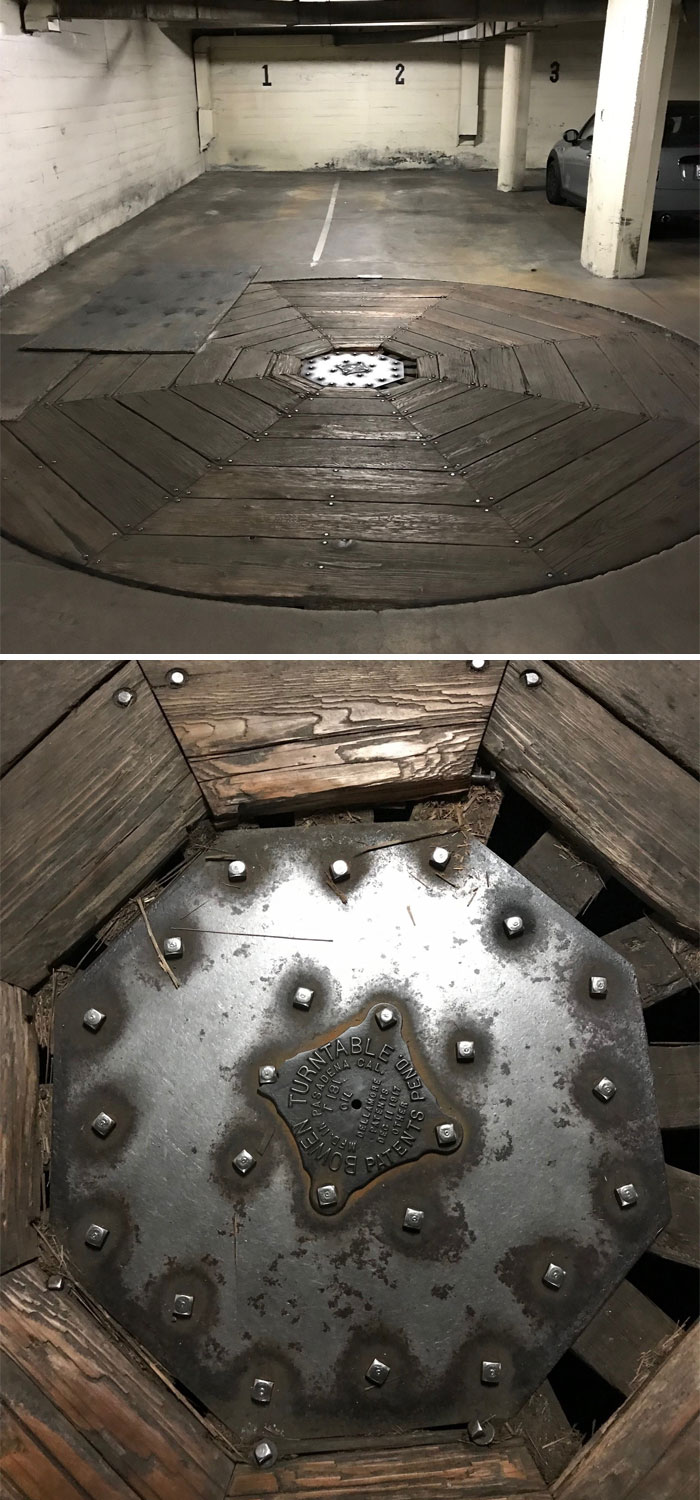
This is an old turntable used for cars back in the day. Some also may call this a Lazy Susan! It was used for cars back in the late 1800’s to early 1900’s for easy access and movement. Cars back had a bigger turning radius so they had the turntable to help out.
The build date and fabrication number was stamped into the center of the steel. You can see that the turntable was built on Dec 11th, 1917. This thing was discovered while doing an earthquake inspection for a large industrial building in DTLA.
dangerous-weird-things-structural-inspections

Image 1: This is a retaining wall failure that happened up the Hollywood Hills.
Image 2: As you can see, the soil began to give way under this driveway and retaining wall which caused quite the problem.
Image 3: It began to pull away from the rest of the concrete driveway and started to tilt towards the down slope of the hill. You can clearly see the separation take place with the cracking wall and concrete slab in this photo.
Image 4: This even effected the home itself, causing the now undermined foundation to settle and dip down on that side of the home.
dangerous-weird-things-structural-inspections
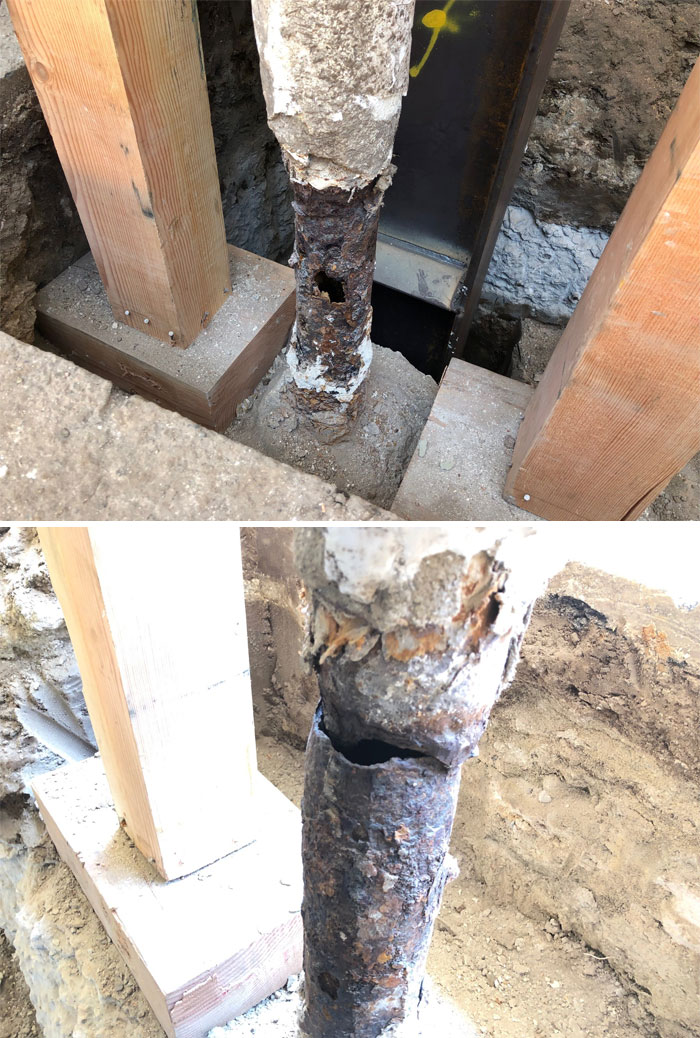
Image 1: This was a column on a soft-story retrofit project we have in Los Angeles. As you can see, the column has rusted to a point that it has become very brittle and weak. At the time this was discovered, emergency shoring was put into place for additional support.
That very same night, the Ridgecrest Earthquake happened. A 6.4-magnitude earthquake struck Ridgecrest, California, some 100 miles away from Los Angeles.
Image2: Once we came back to the property the very next day, we noticed the entire column had snapped in half due to the movement from the quake! If we hadn’t installed that additional shoring, the unit above may have met the ground…
dangerous-weird-things-structural-inspections
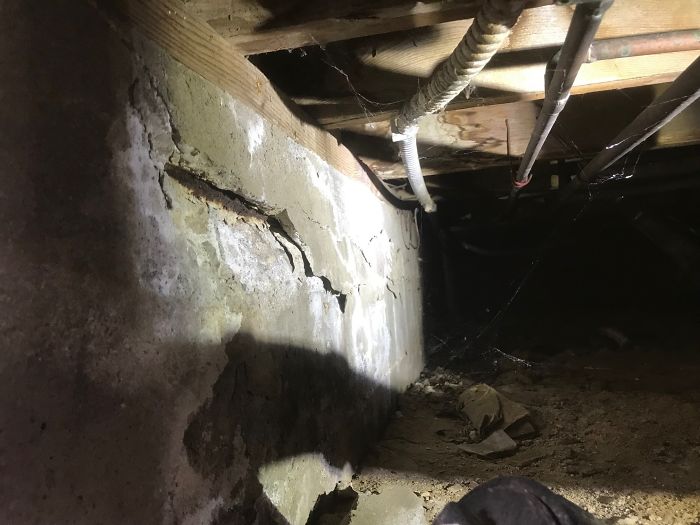
This was some pretty bad spall damage on an old 1900’s foundation we inspected. This section will probably have to be replaced.
dangerous-weird-things-structural-inspections
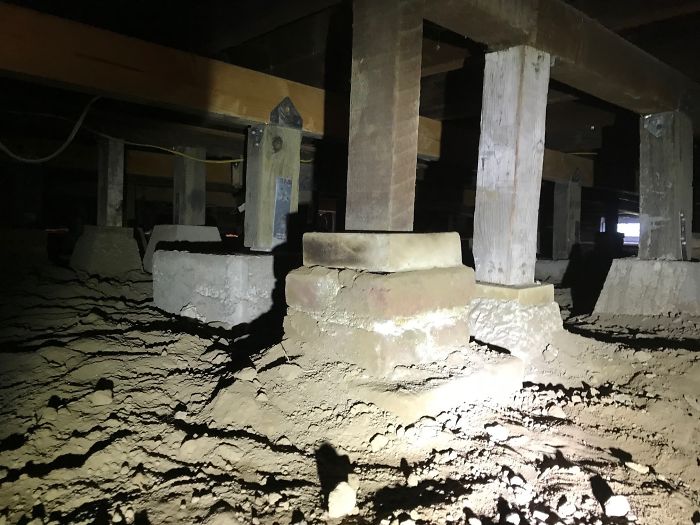
This is a few generations of post & piers. The one in the foreground is the oldest, to the right of that you have one built a little later on, and the other two are from the past few decades. A supporting family.
dangerous-weird-things-structural-inspections

This was a nasty brick foundation we inspected. Tons of wood rot accompanied the decaying brick and made for a foundation in need of drastic work.
dangerous-weird-things-structural-inspections
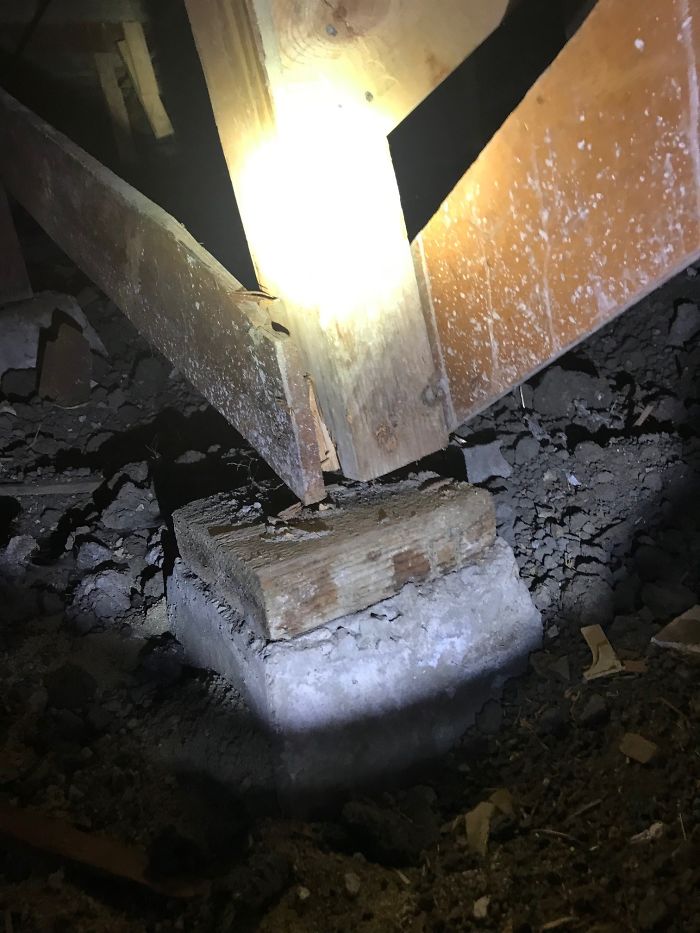
An older pier that wasn’t even in contact with the post above. This would normally cause some dipping in the floors over time.
dangerous-weird-things-structural-inspections
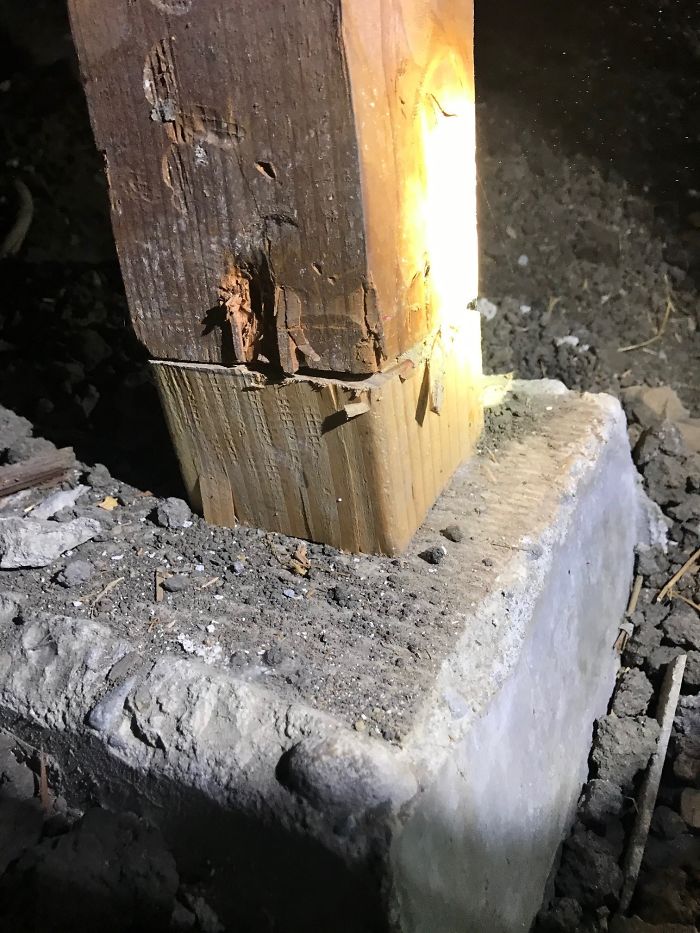
This is a post that had been spliced together with another random piece of wood. Why somebody would do this is beyond me.
dangerous-weird-things-structural-inspections
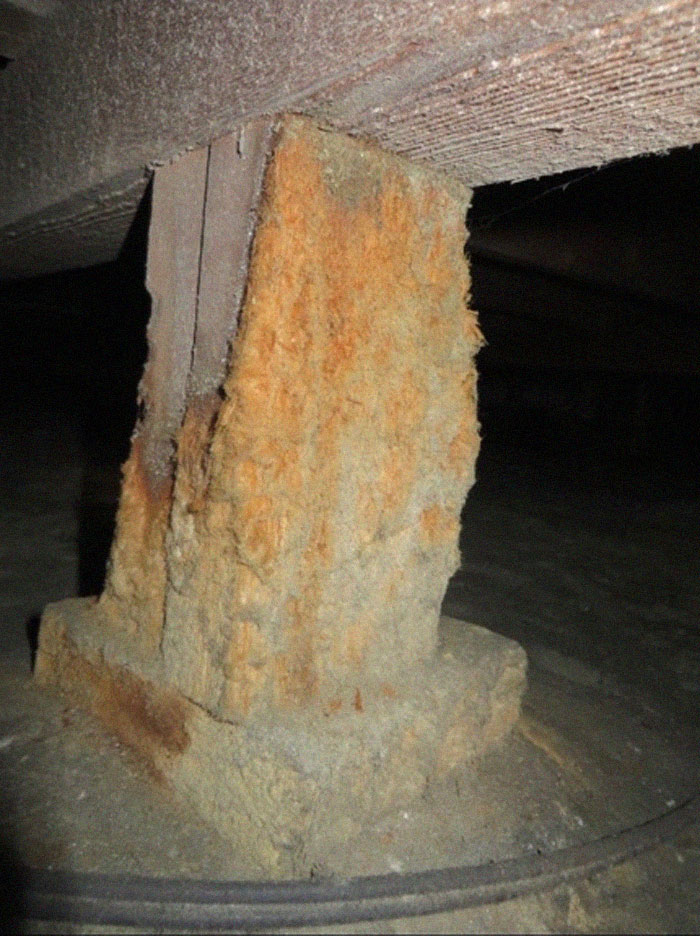
MDF, or Medium Density Fiber Board, is used in a lot of furniture and aesthetic pieces. This type of material should NOT be used for anything structural. A lot of the time it isn’t treated well for moisture or natural elements. This is what happens when it becomes exposed to water over a short period of time… it will begin to fray out and decay. It looks like mold, but it’s actually the wood fibers being pulled apart due to moisture. Don’t use MDF for your structural work!
dangerous-weird-things-structural-inspections
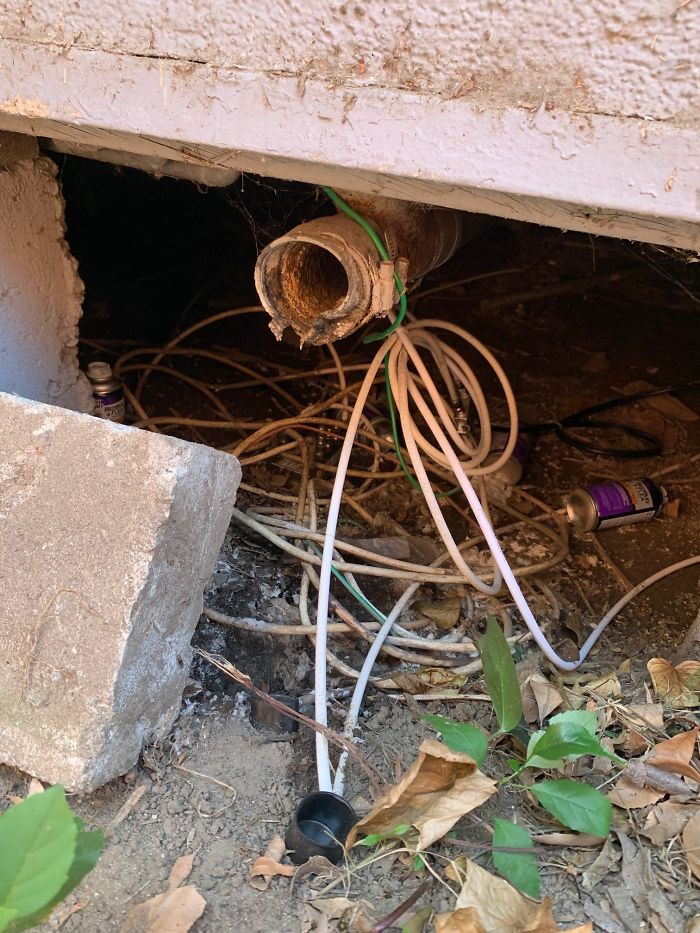
Right at the entry to this crawlspace was an exposed, broken sewage line. It was active and it was pooling up for quite some time. We skipped this crawl until it was fixed. (Insert barf emoji here)
dangerous-weird-things-structural-inspections
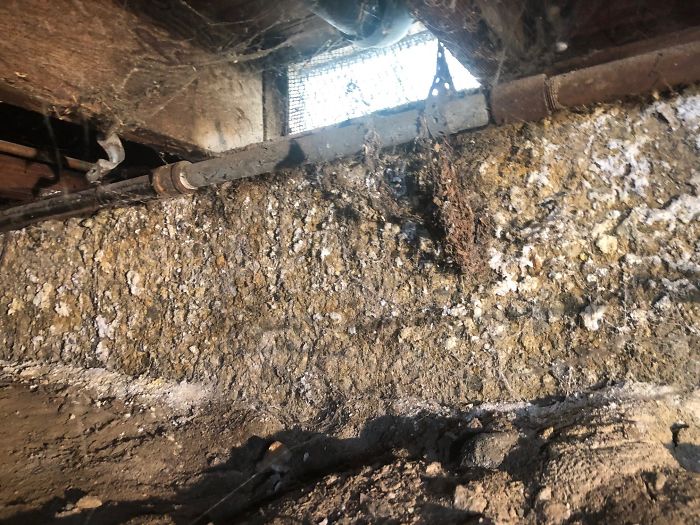
This is quite the shabby foundation. I’ve showed many like it but this one shows a bit more detail. You can clearly see the degradation of the concrete with the exposure of aggregate. There is also many signs of water intrusion, such as the white, chalky substance known as efflorescence (mineral deposits left behind after water intrusion). This foundation can’t even be properly retrofitted because the concrete isn’t capable of holding in the bolts.
dangerous-weird-things-structural-inspections
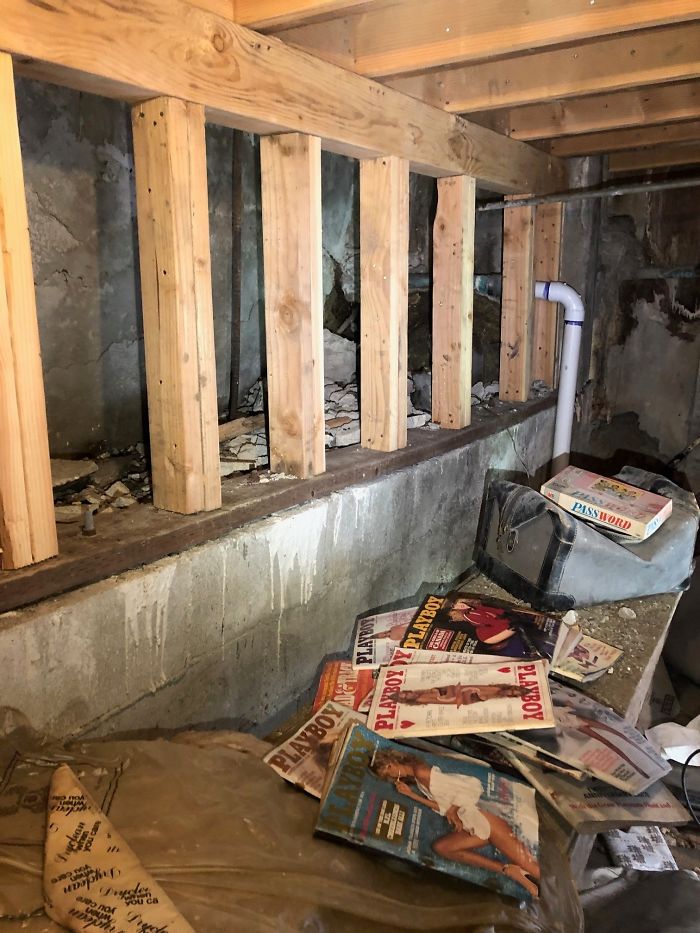
We found some vintage… booklets in the crawlspace of this home. No, we did not take them and sell them to collectors.
dangerous-weird-things-structural-inspections
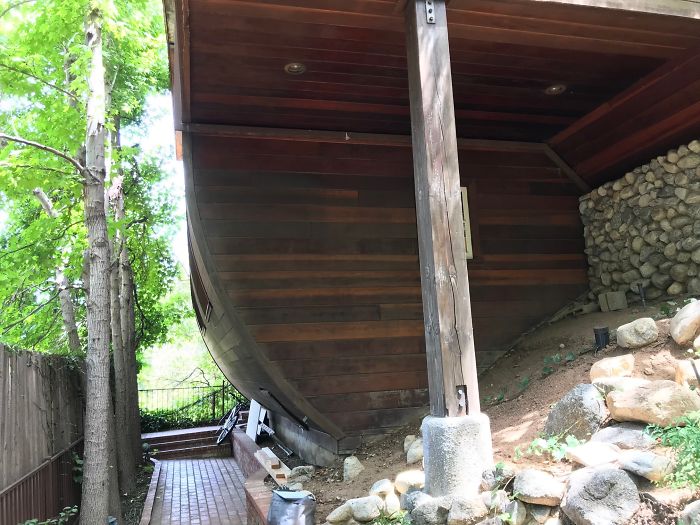
This was an interesting boat-shaped home we inspected up in the Hollywood Hills. Unfortunately it was the only angle we got but it was still a very unique home that I wanted to share. If the floods come, they will be ready.
dangerous-weird-things-structural-inspections
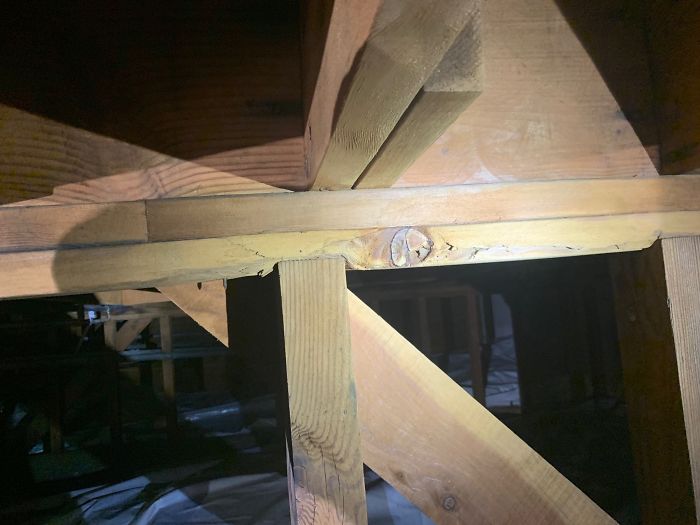
This is a 3-story structure we inspected in LA. Tons of pressure was exerted downward onto these framing top plates and they began to absorb some of the pressure. This, over time, can cause some serious issues.
dangerous-weird-things-structural-inspections
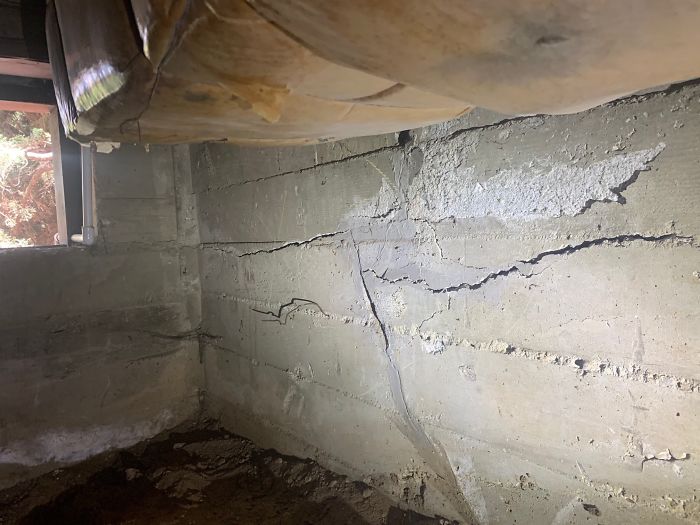
This is a concrete foundation that had some pretty bad stress cracking on one side. Somebody had tried to epoxy inject the cracks, but the settlement caused them to simply reopen and expand even further down the wall.
The cracking continued for about 10 feet before stopping. There were also some signs of water intrusion.
dangerous-weird-things-structural-inspections
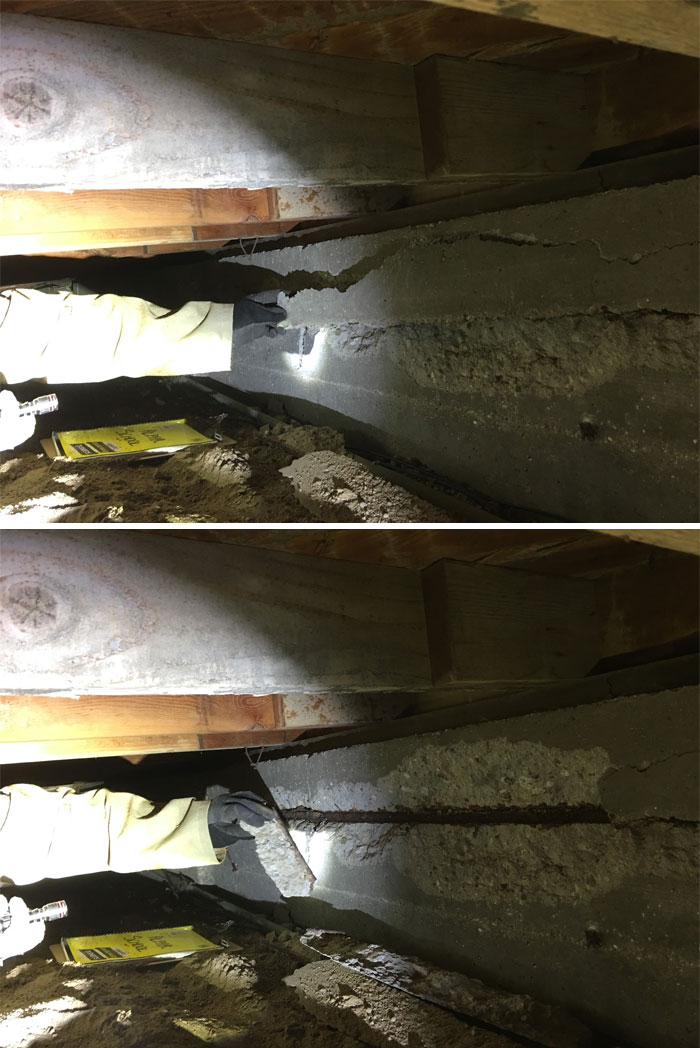
This was a foundation that had very bad spall damage. Spalling concrete occurs when water penetrates the concrete and causes the rebar to rust/oxidize. This will then cause it to expand and break the surrounding concrete.
That piece of concrete fell right off with not much effort at all. This exposed the rusted rebar underneath. The cause of this is usually due to poor waterproofing or an area of land being graded towards the structure’s foundation. With nowhere else for the water to go, it penetrates the porous concrete. This section will have to be replaced.
dangerous-weird-things-structural-inspections
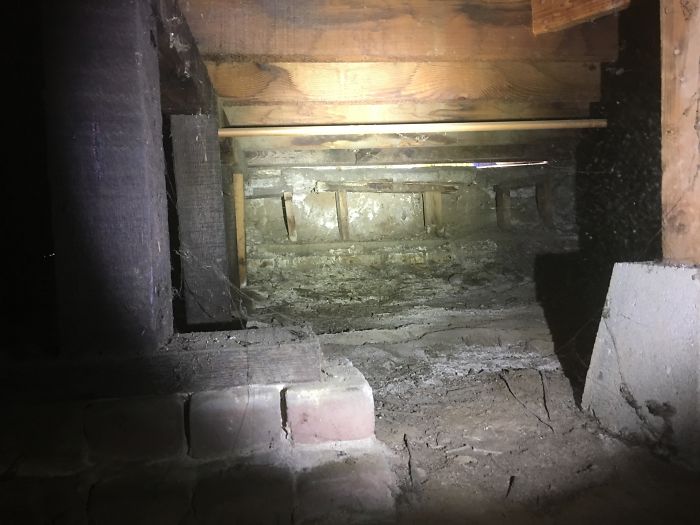
There is a lot going on in this one. First off, the post and “pier” to the left is made up of damp wood and decaying bricks. Secondly, in the back you can see that there is some parts of the framing/cripple wall that aren’t connected. The foundation is brick and has settled drastically. The framing above that has been covered in concrete on the exterior, done as a sort of “sister foundation.” Lots of moisture was also discovered.
dangerous-weird-things-structural-inspections
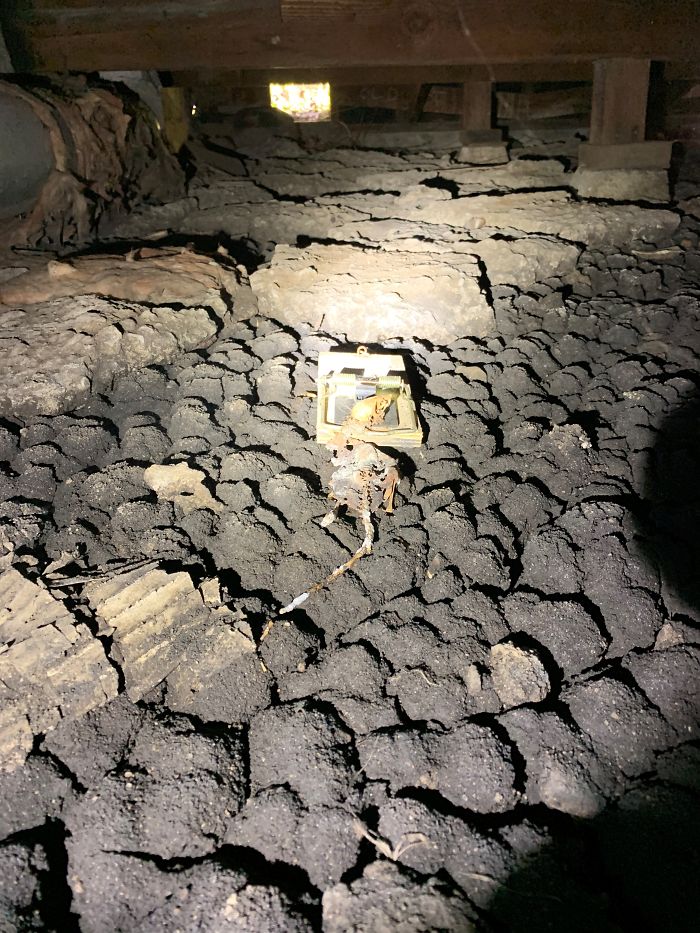
A dead rat… nothing more.
dangerous-weird-things-structural-inspections

This was the skull of some very large animal we found under a crawlspace. It isn’t just a normal rat or opossum skull as it was the size of a basketball. My guess would be some sort of alien (such as E.T.) or a Silver Back Gorilla, but I’m not too sure.
dangerous-weird-things-structural-inspections
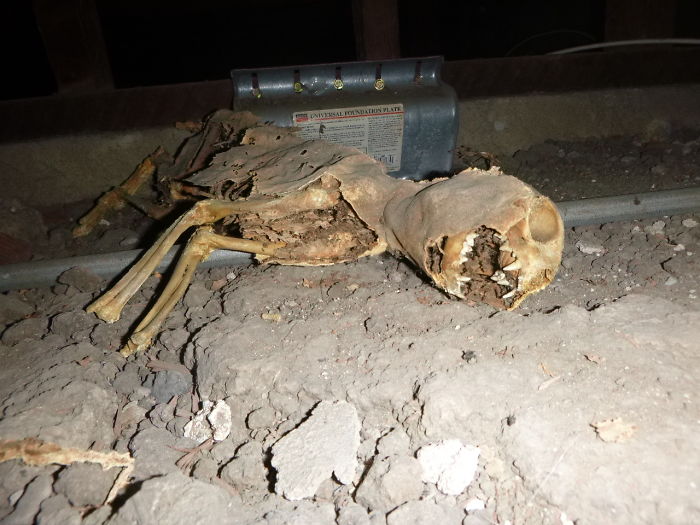
Rip whatever animal this was. I can’t tell what type of animal it was but it seemed like a nice guy/girl.
dangerous-weird-things-structural-inspections
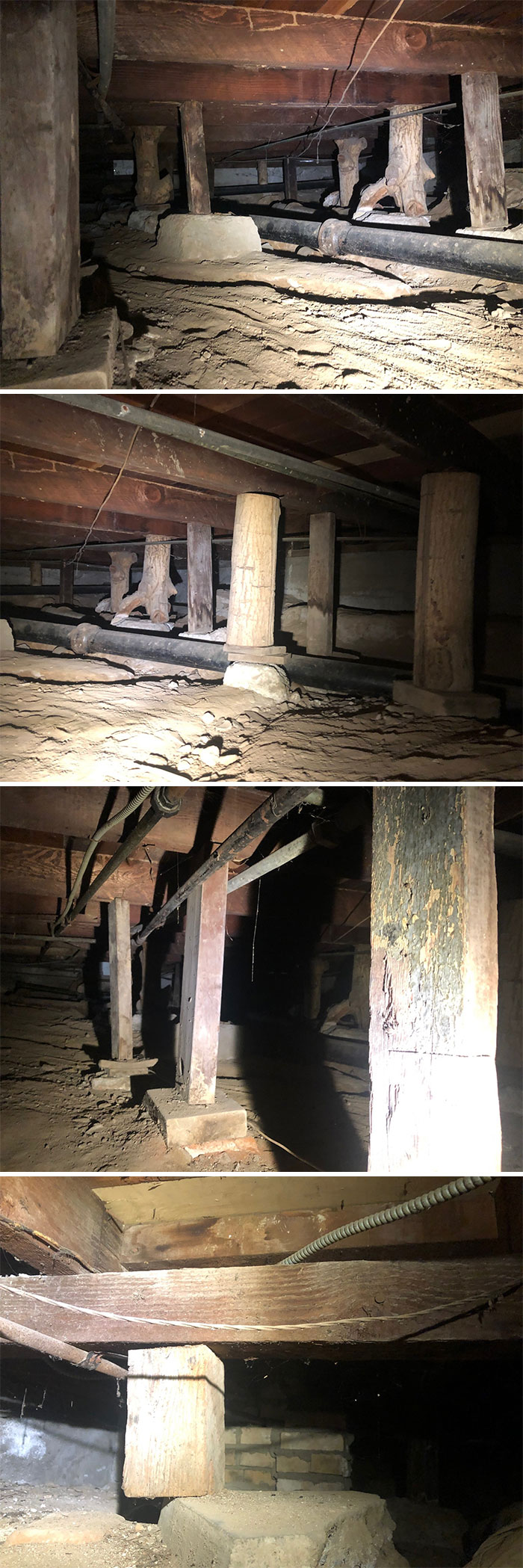
This had to be the first image because it is by far my favorite this week. The absolute definition of a “DIY” project. This entire crawlspace was filled with tree branch posts, many of which were resting upon rocks and logs. I like to think it’s just a person’s bad hiding spot in a game of prop hunt. This one will fall some day. I will keep you posted.
dangerous-weird-things-structural-inspections
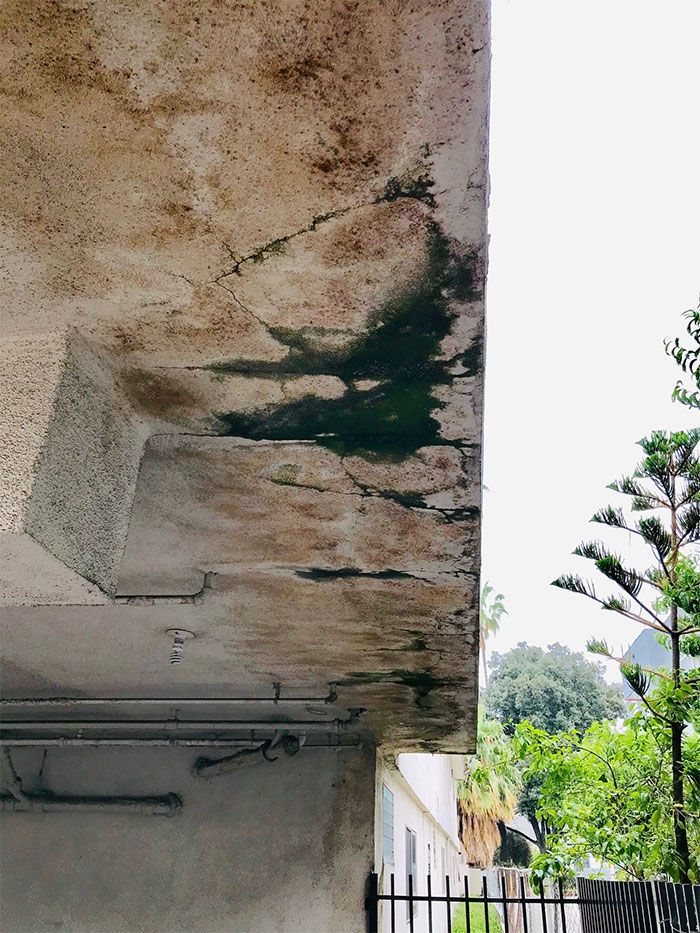
This was some very bad wood rot caused by years of leaking water and neglect. As you can see, the cantilevered area is starting to bow down due to the weight of the now very damaged and saturated framing. Tis but a minor leak.
dangerous-weird-things-structural-inspections
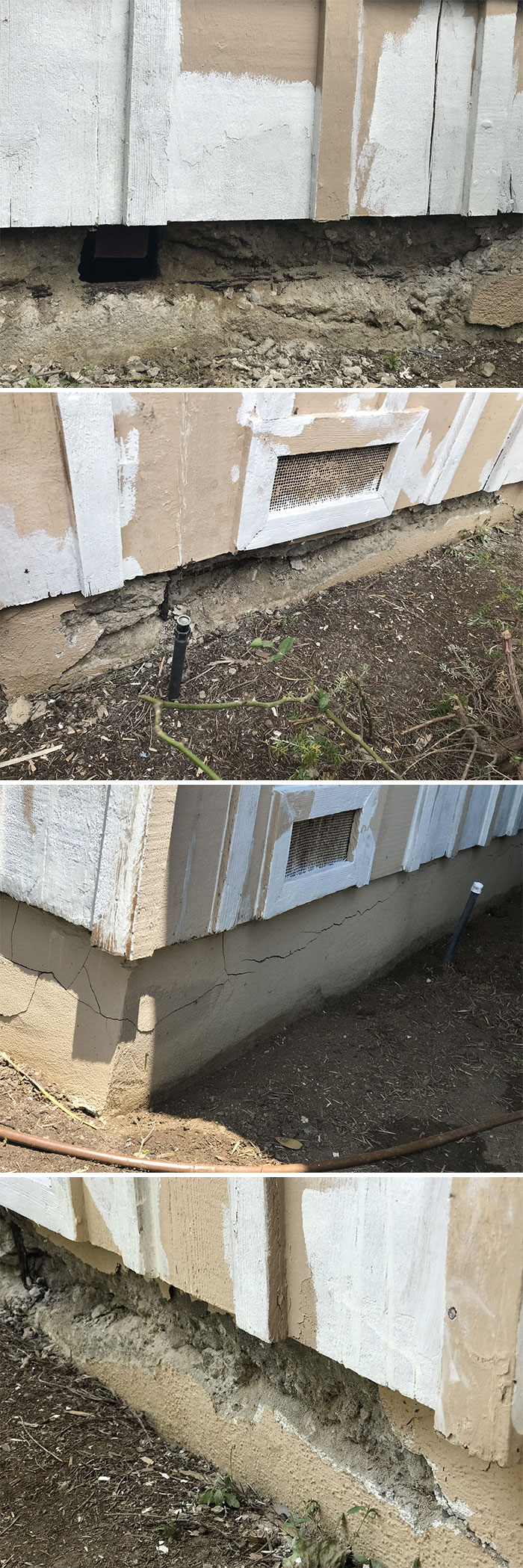
This was a deteriorating foundation that had some significant spall damage. You can see the old, now rusted rebar with chunks missing.
This can cause some pretty significant damage to the rest of the home, especially on a hillside property.
This may just seem like stucco cracks, but I assure you it’s a bid more serious than that.
This sort of thing can be spotted pretty early on if one takes the time to look.
dangerous-weird-things-structural-inspections
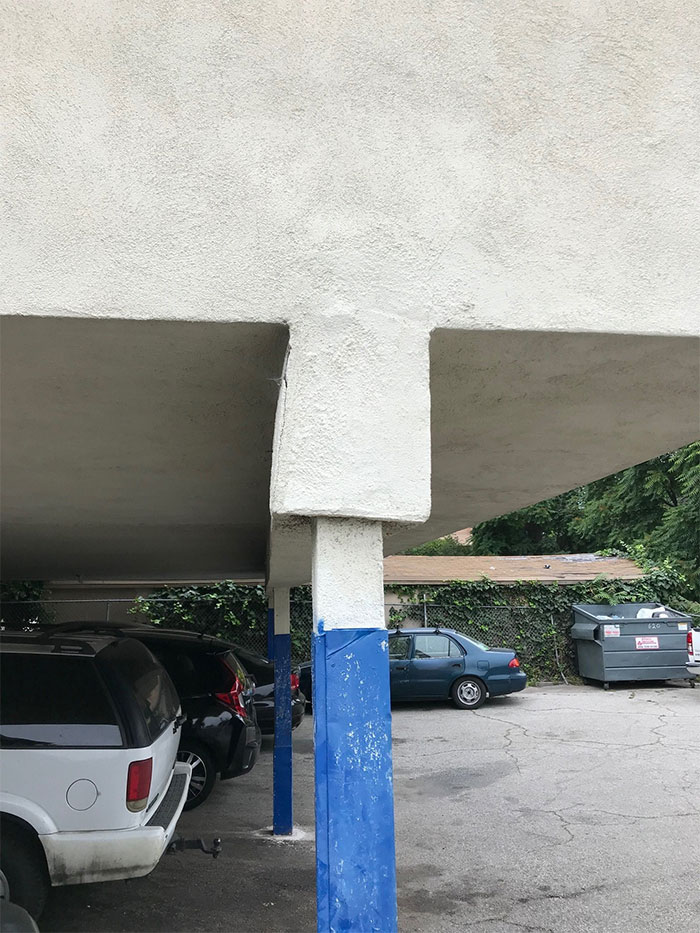
A displaced structural beam under a few dwelling units. This was an inspection for an earthquake retrofit.
dangerous-weird-things-structural-inspections
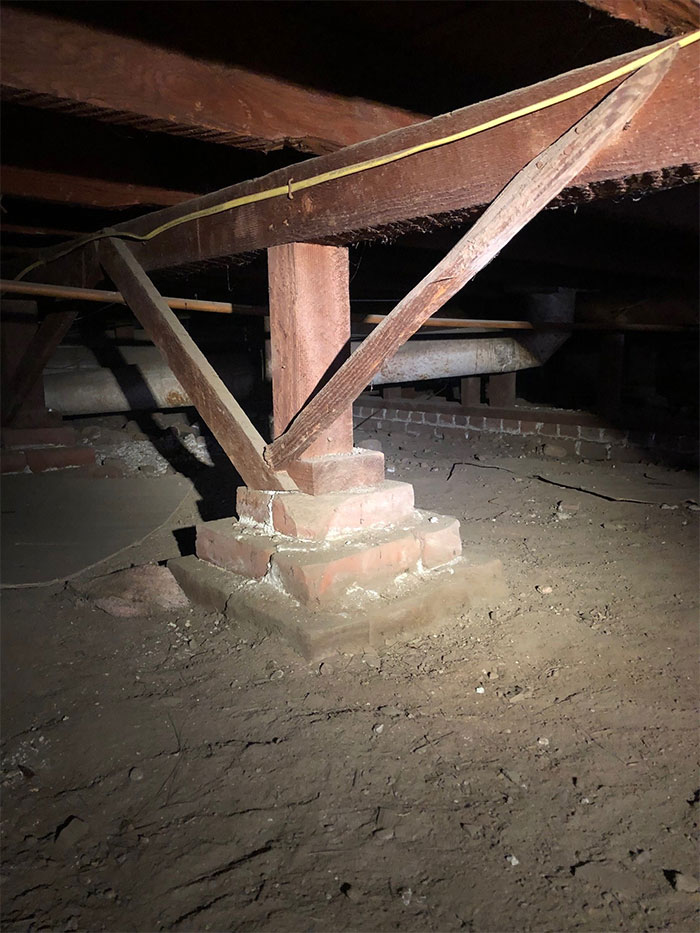
A brick pyramid made by the ancients to hold up this post.
dangerous-weird-things-structural-inspections
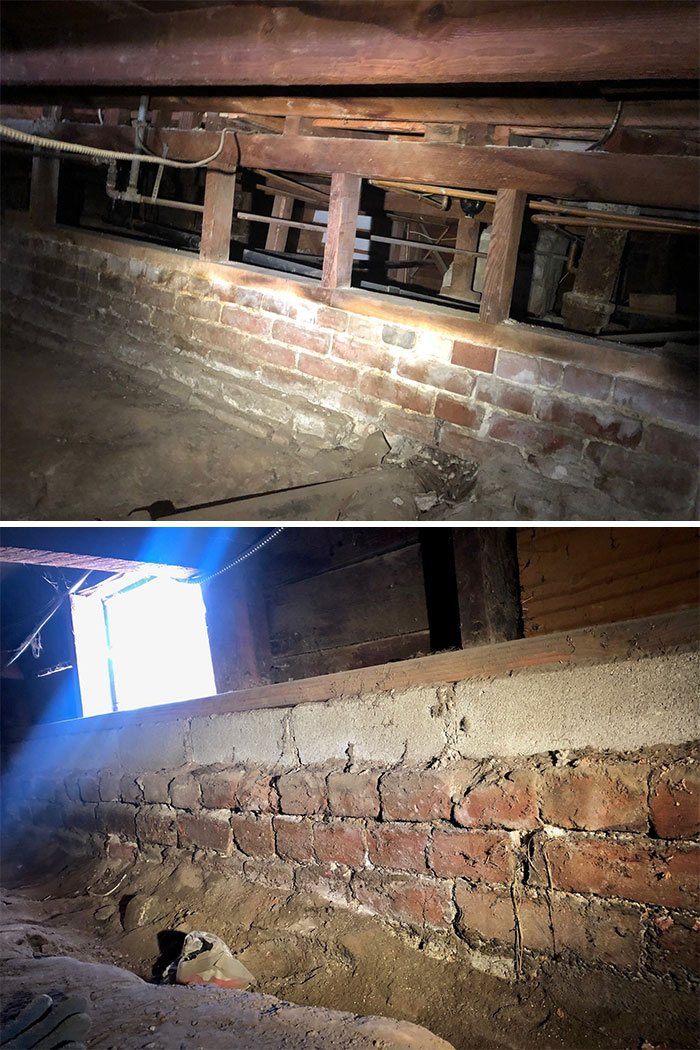
A surprisingly intact brick foundation. Not very common to see a masonry wall from the early 1900’s still standing with solid mortar. However, the cripple wall isn’t braced and should be upgraded.
Another part of this brick foundation. This portion was deteriorating but a decent amount of this foundation was still intact.
dangerous-weird-things-structural-inspections
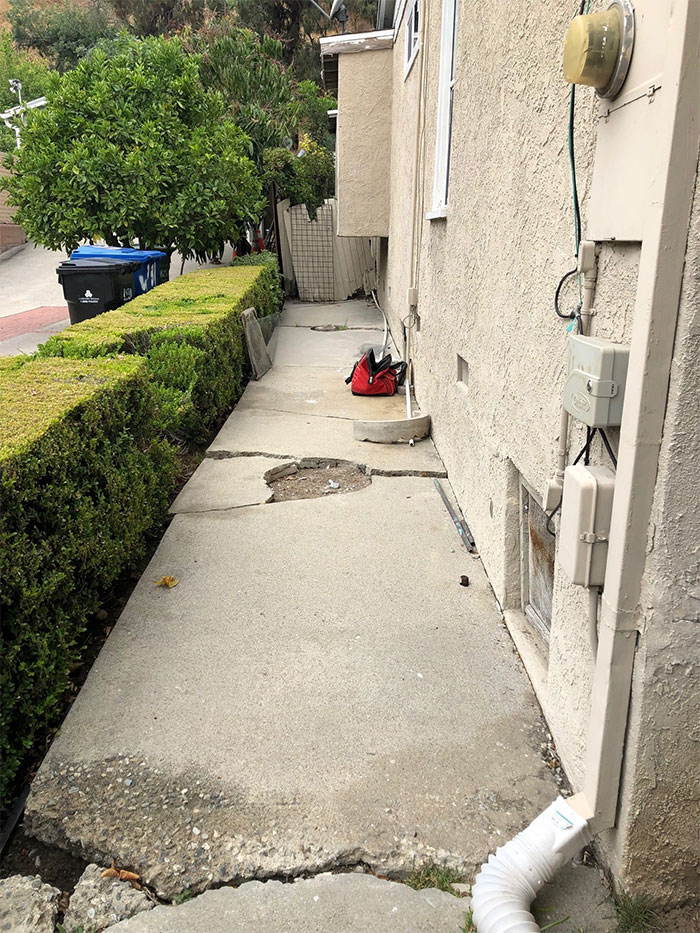
This property had very bad drainage and began sinking on one side. At length, this brought the perimeter foundation and exterior concrete pathway to wedge together at the connection point. This caused the concrete pathway to crack and break apart and lift. Gnarly.
dangerous-weird-things-structural-inspections
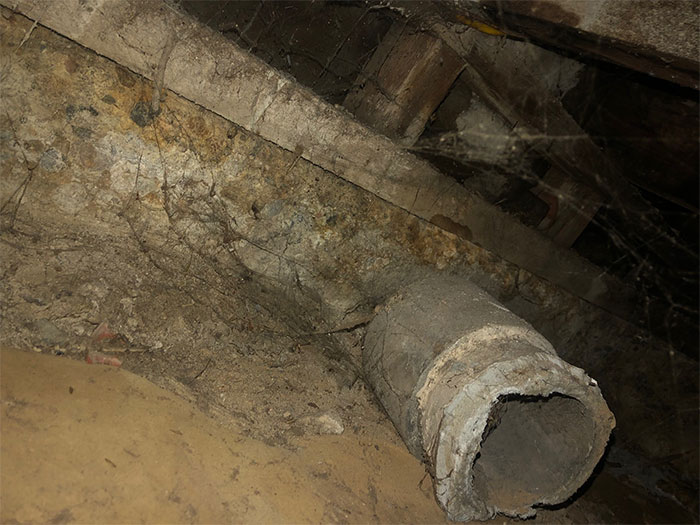
And here we have the entrance to the next level of Super Mario Bros. It doesn’t actually go through the foundation wall, though by the looks of it, that wall could be easily broken apart. The whole foundation needs to be replaced. Very brittle.
dangerous-weird-things-structural-inspections
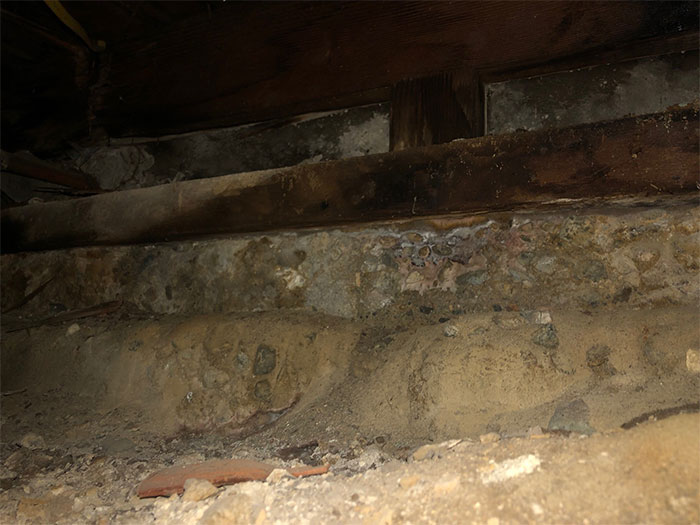
If you’re ever dealing with old concrete, one thing you can always look out for is exposed aggregate. Aggregate is any material (usually stone, chunks of old concrete, sand, gravel) that is used to mend the concrete and hold it together. If the aggregate is clearly visible and exposed on the exterior, that’s usually a sign that it’s in bad shape.
dangerous-weird-things-structural-inspections
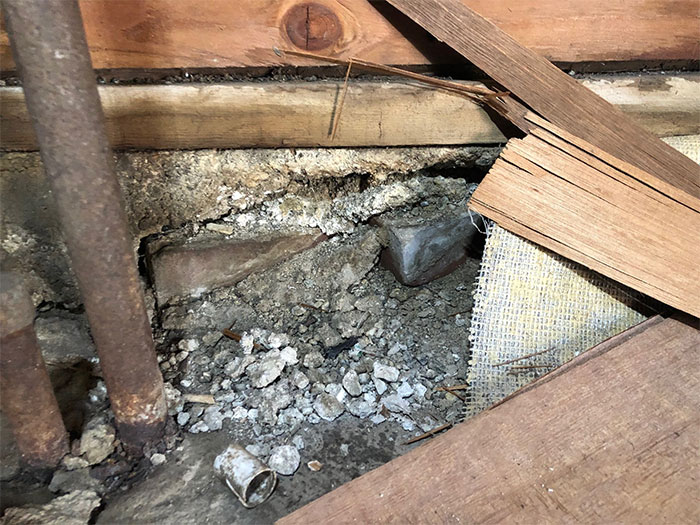
Another very brittle foundation with no original retrofitting or anything.
dangerous-weird-things-structural-inspections
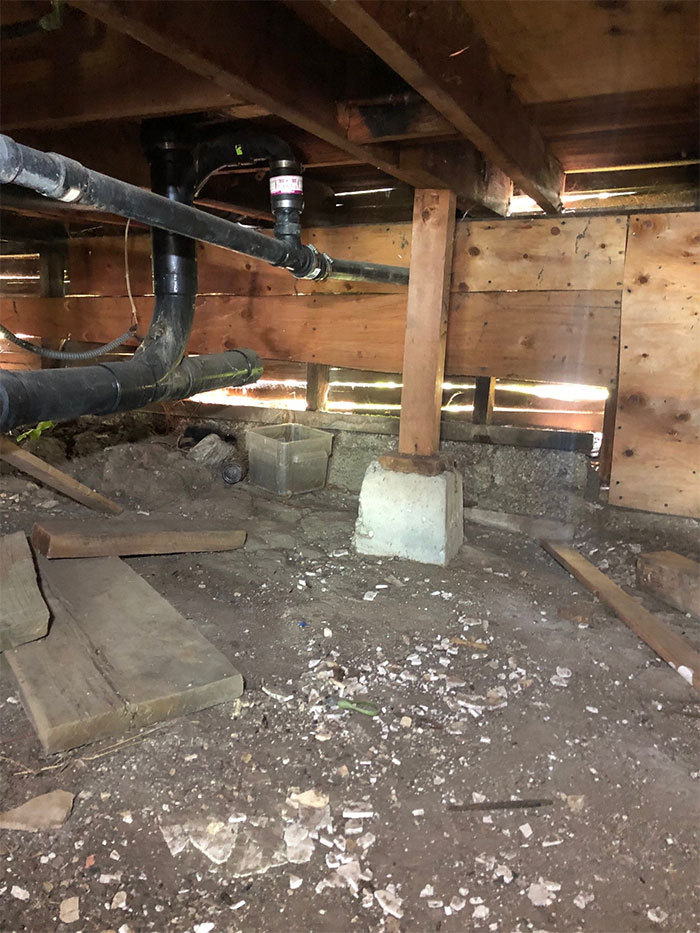
This is a very poorly done cripple wall with DIY shear walls. A cripple wall is simply a wall with “cripples” (or short studs) to help with lateral movement in seismic activity. They act as a cushion for when the house shakes. The shear wall is used to reinforce these cripple walls so they don’t just collapse to the side. They help resist lateral motions.
dangerous-weird-things-structural-inspections
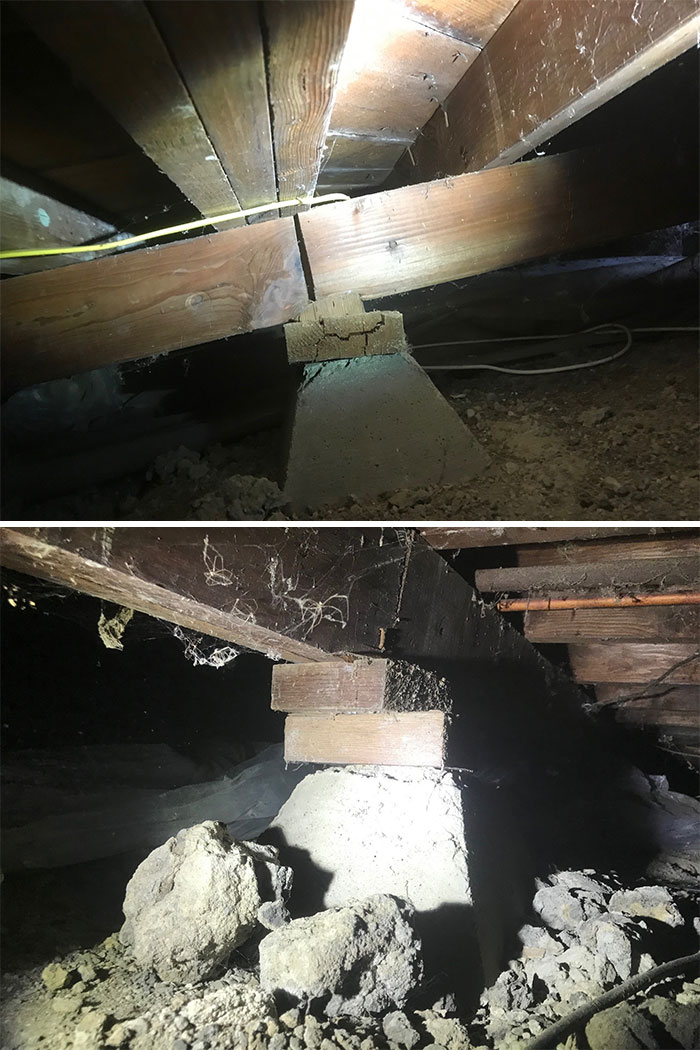
A nice little girder with no bracing. It’s also just smashing down the existing “post” and pier.
You’ll see this sort of thing all over LA. Instead of putting in a proper post, people will install random pieces of wood under a girder to help support the home. The problem with this is that it’s almost never braced and the wood used is often untreated. They rot much faster than most pieces. I’ll also add that this doesn’t necessarily compromise the structure.
dangerous-weird-things-structural-inspections
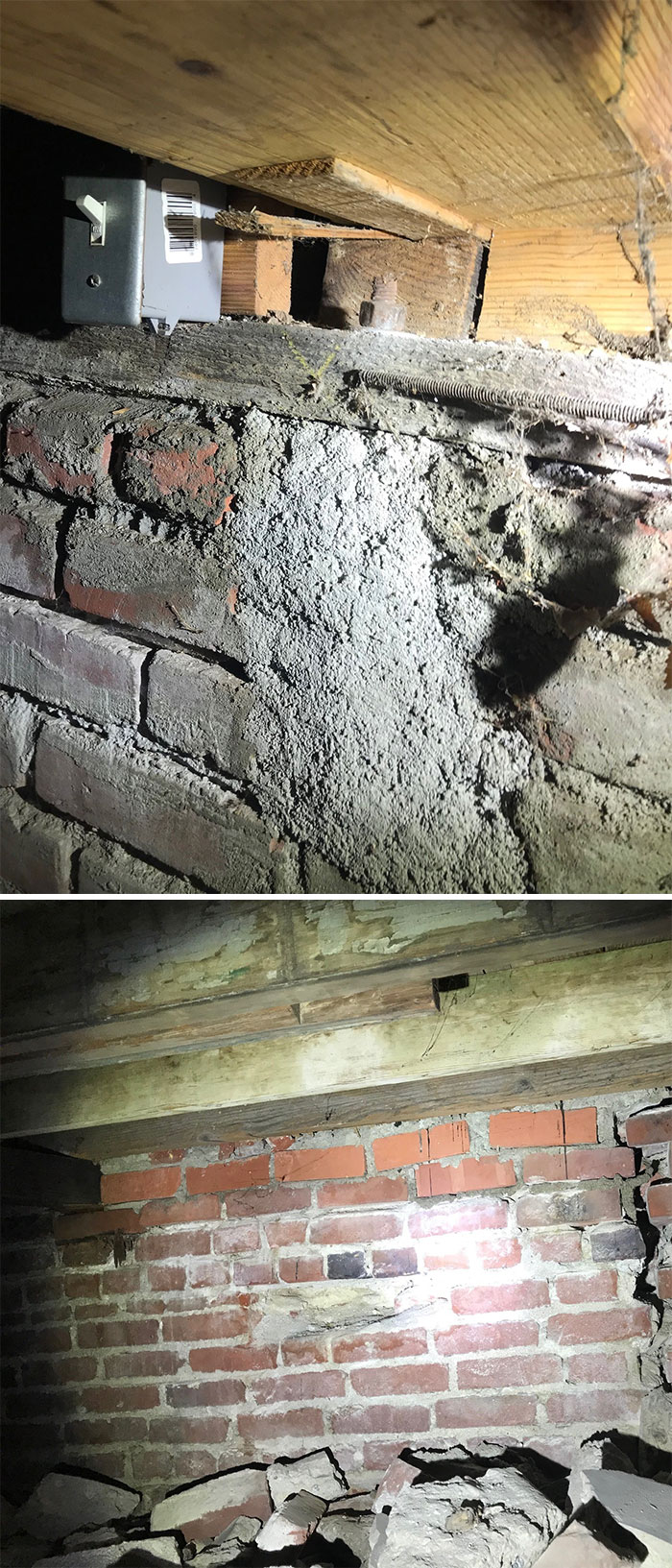
This is a unreinforced brick foundation. If you’ve ever dealt with older foundations, especially ones made of river rock or brick, you’ll know that they can’t be properly retrofitted up to current code. Some contractor/homeowner decided to circumvent this by pulling out some bricks, putting in a patch of concrete and then putting in an anchor bolt. This is pretty funny and maddening at the same time.
This is the same brick foundation. This time we have the opening to another dimension to the right. This whole foundation needs to be replaced or sistered.
dangerous-weird-things-structural-inspections
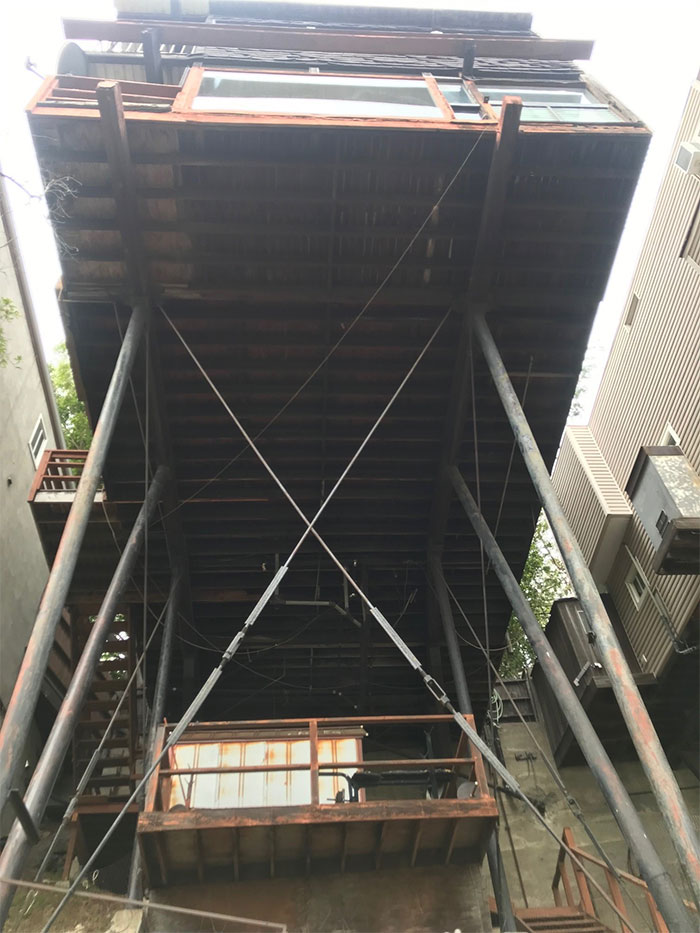
This was a gnarly stilt home we inspected for seismic reinforcement. I’m not entirely sure what the outcome will be but it should be an awesome project!
dangerous-weird-things-structural-inspections
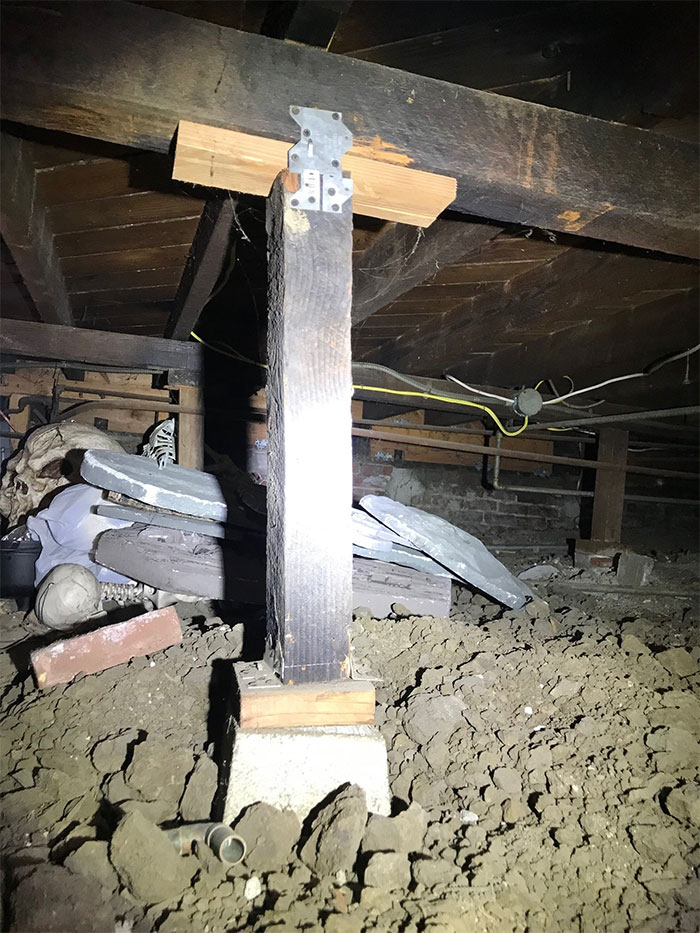
As I was thinking of what to say for this caption I forgot there was a plastic skeleton and giant skull to the left and felt any other comment besides mentioning those would be a disservice to you guys. But the post is a bit wonky too.
dangerous-weird-things-structural-inspections
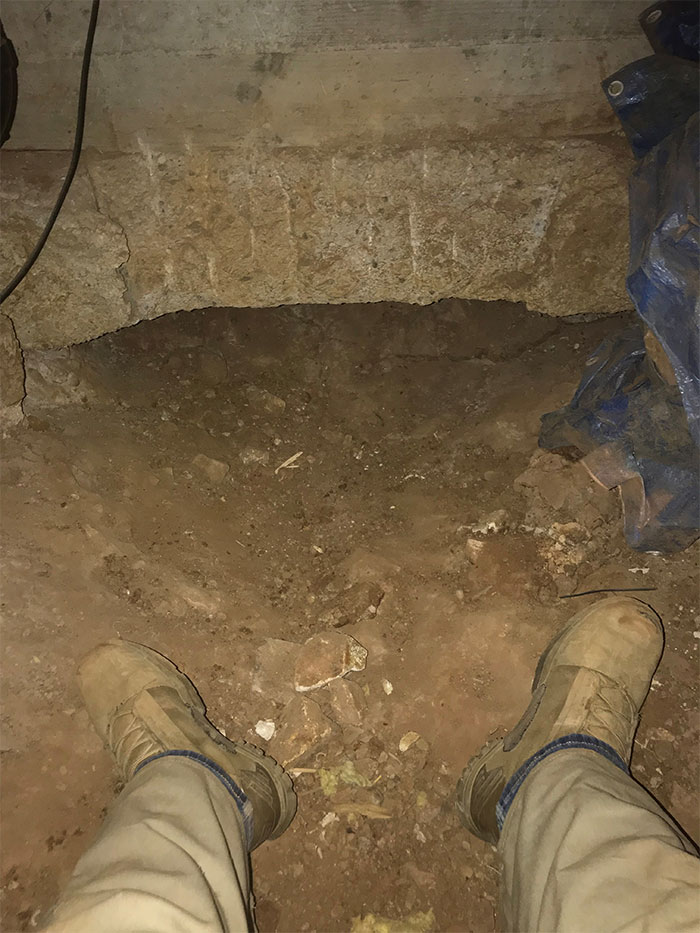
This is another property with burrowed holes going under the concrete foundation. This time there were 8 of these… It’s like a maze down there.
dangerous-weird-things-structural-inspections
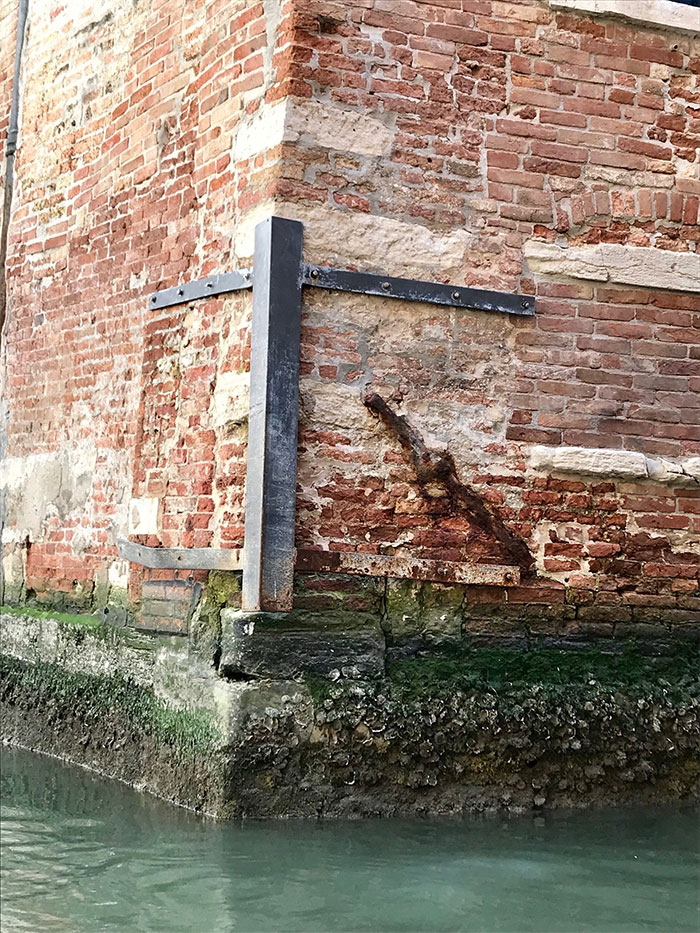
Our office manager was in Venice, Italy and saw this poor little wall in need of some help. I’m happy to announce we will be expanding to the EU!
dangerous-weird-things-structural-inspections
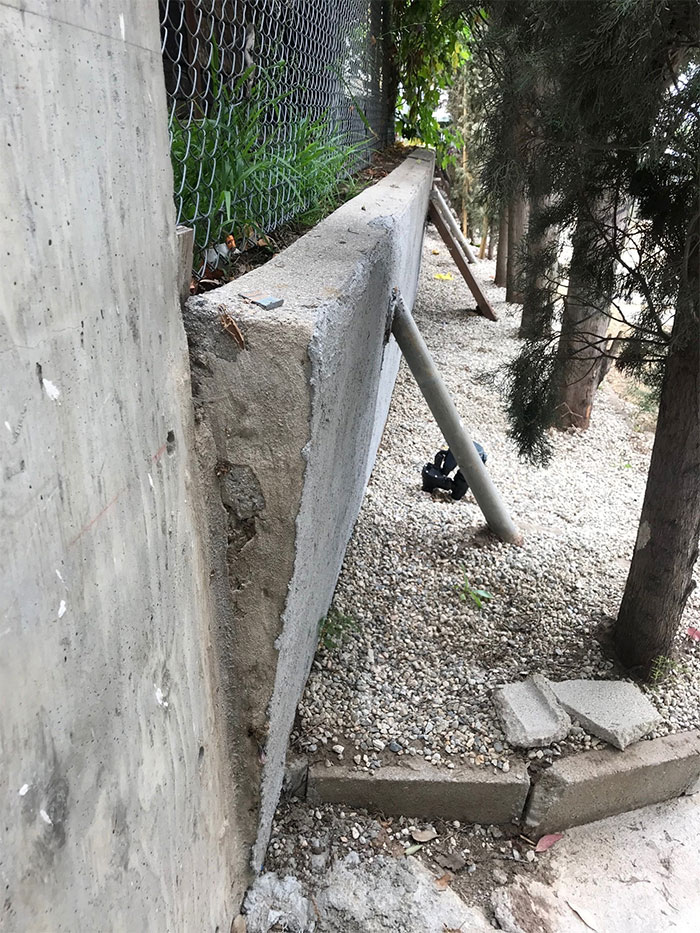
Here we have a classic garden wall with improper footings and tie-ins to the other wall. It could also be the result of a “surcharge.” A surcharge is the result of pressure being built up against a surface, usually caused by the settlement of nearby structures, such as a house. I put that in layman’s terms so don’t yell at me for not being technical.
dangerous-weird-things-structural-inspections

As you can see, the slab foundation has a decent sized crack running through it, causing sloping and other areas of the home to crack.
Here is another photo of the kitchen tile that has separated and cracked down the grout line. To the left of that gap is a large retaining wall on the front portion of the home. The hillside in the back was giving way and pulling the rest of the home with it. This then created a gap between the retaining wall and the rest of the structure. It was sloping about 8 inches down toward the back and creating many cracks along the way. You can see down into the crawlspace from this gap.
This is a shot from the exterior of the home. This isn’t your normal stucco crack, it’s a massive structural fracture caused by the severe settlement. These are the cracks you should be worried about.
dangerous-weird-things-structural-inspections
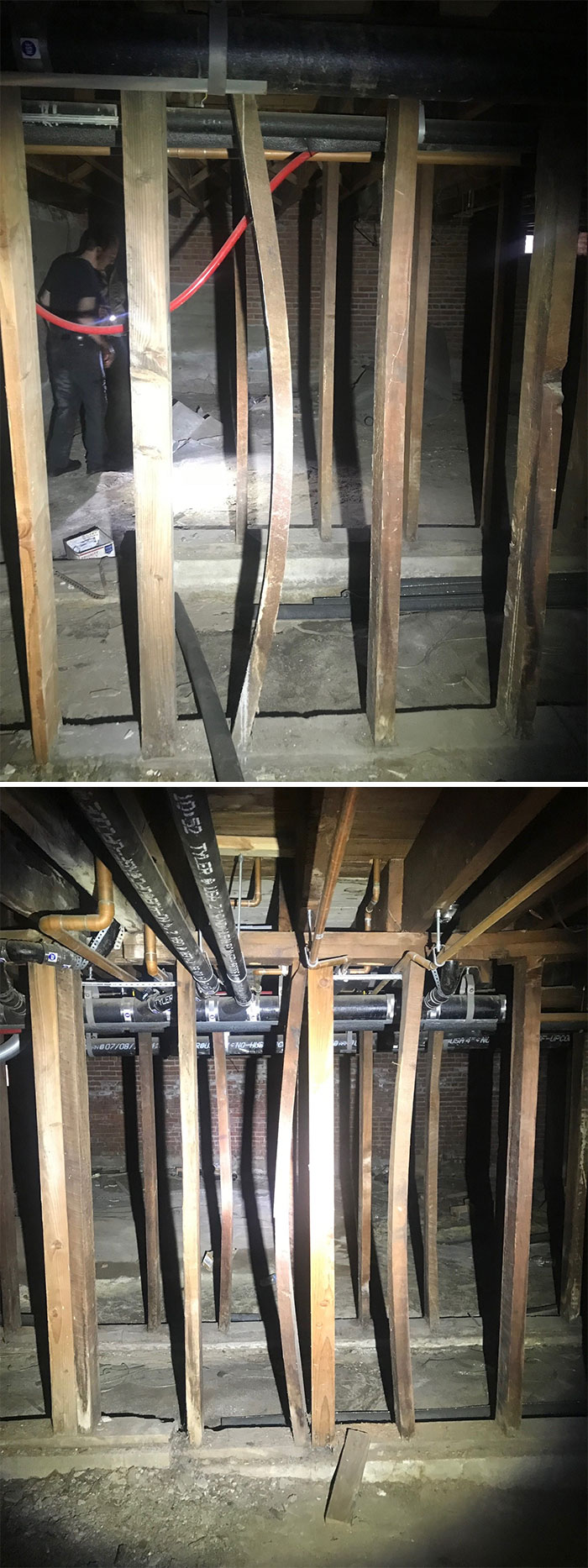
This was an old 1900’s apartment building that was being held up by some less then effective stud supports. You can see the newer members to the right and left of the original support. They had to trim down the newer ones to compensate for the sagging that was caused by the originals. Scary stuff.
dangerous-weird-things-structural-inspections
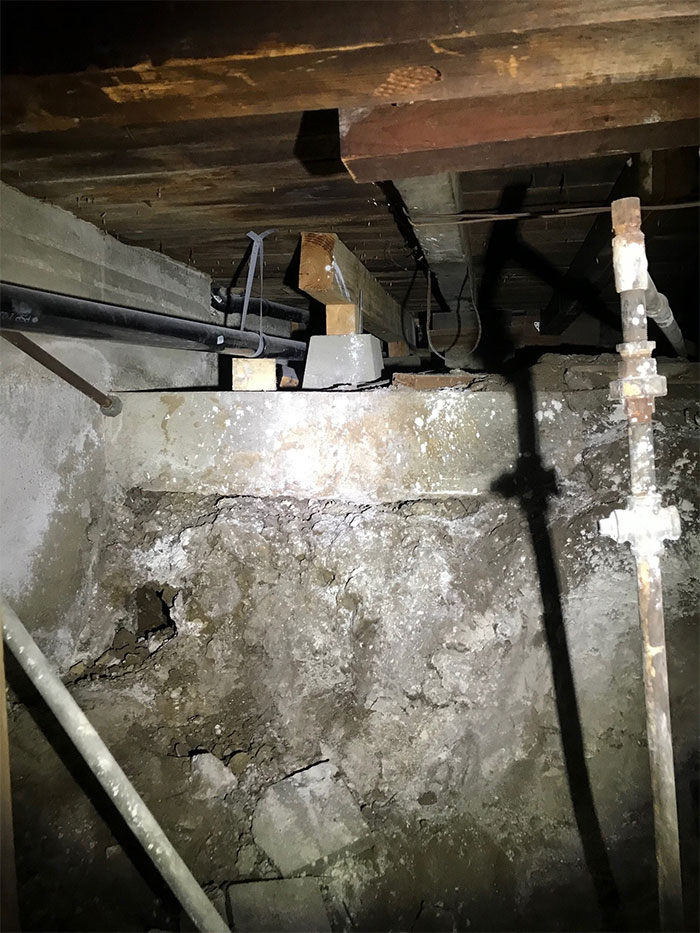
This is just a mess.
dangerous-weird-things-structural-inspections
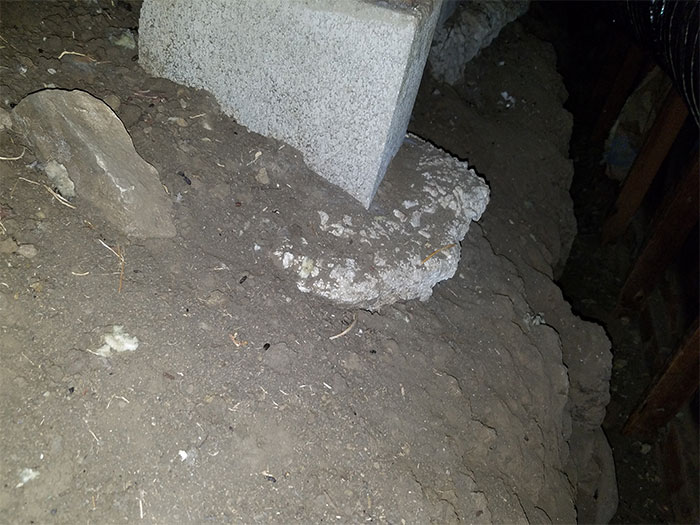
This is what we call an undermined footing. It sits below the post & pier for deepened support but is exposed and could fail if the dirt was moved.
dangerous-weird-things-structural-inspections
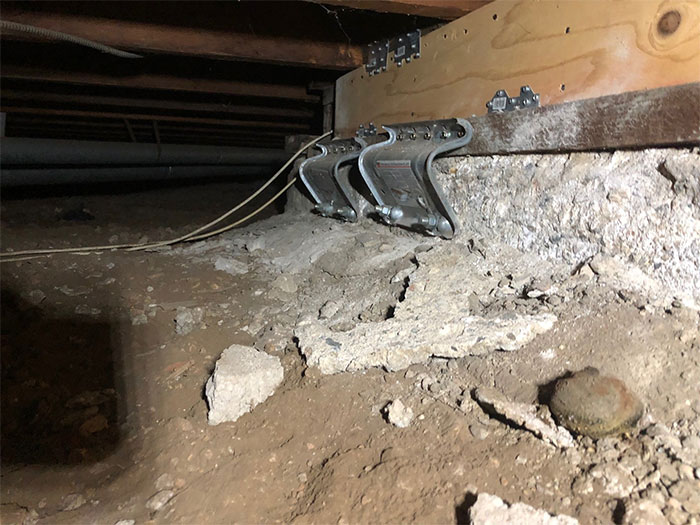
Universal foundation plates bolted right next to each other. They did this because they were required to put a certain amount per code, but the concrete to the right couldn’t hold a bolt without crumbling. This whole foundation should have been replaced.
dangerous-weird-things-structural-inspections
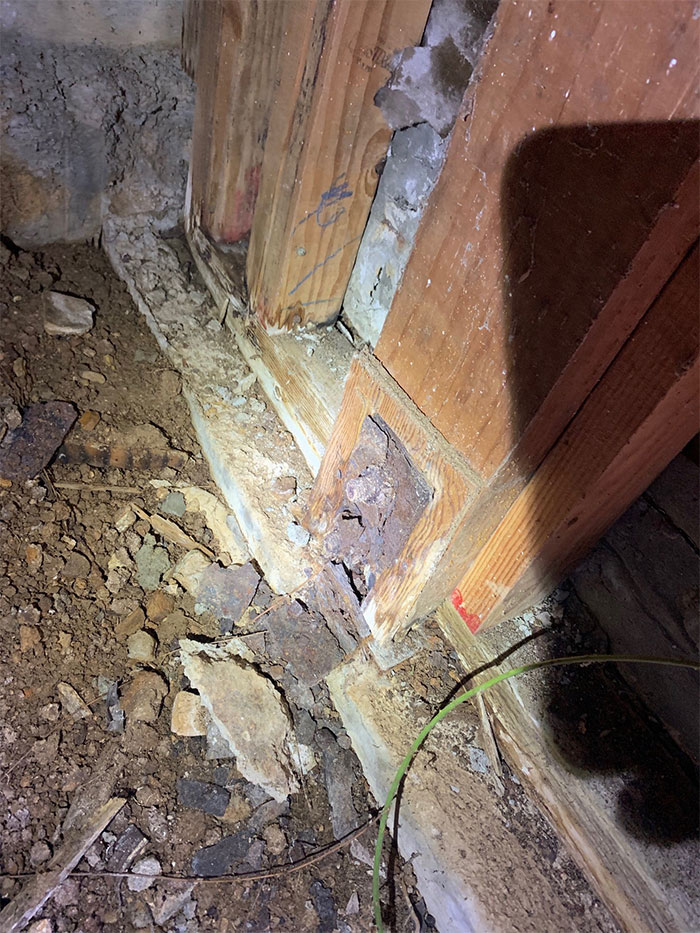
I’ll let you guys tell me what’s going on with this one.
dangerous-weird-things-structural-inspections
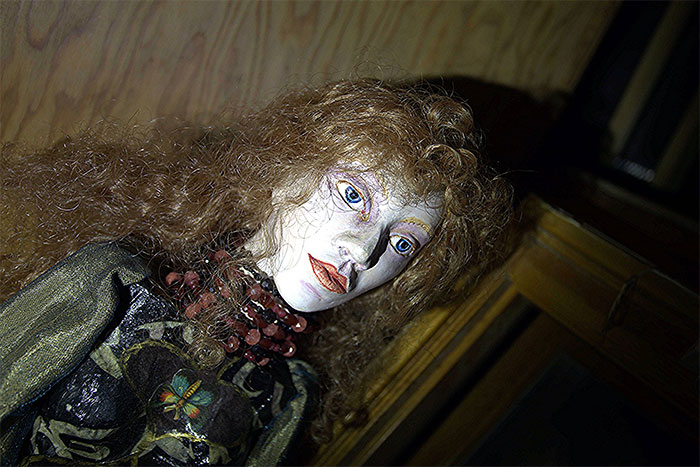
We’ve seen a few dolls under homes before, but this one may take the cake on the creepiest one so far.
dangerous-weird-things-structural-inspections

A nasty, old brick foundation under an early 1900’s home. This house was resting right on top of these dusty and decaying bricks and had no other reinforcement. Scary.
dangerous-weird-things-structural-inspections
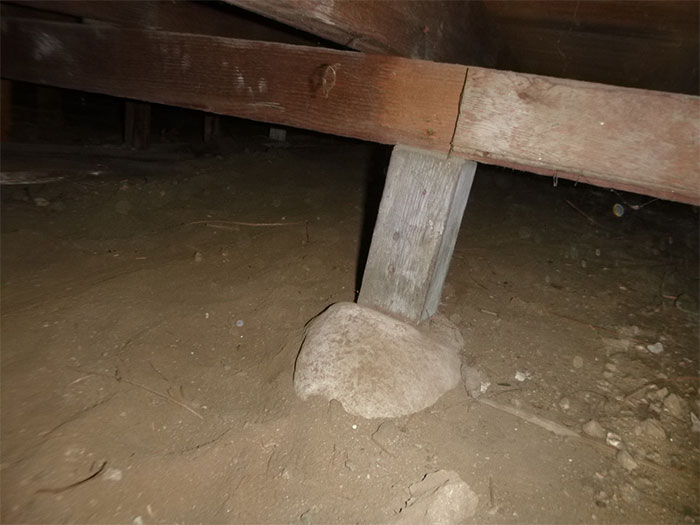
Yes, that is a stone acting as a concrete pier for the post. *Insert joke about the post being stoned here*
dangerous-weird-things-structural-inspections
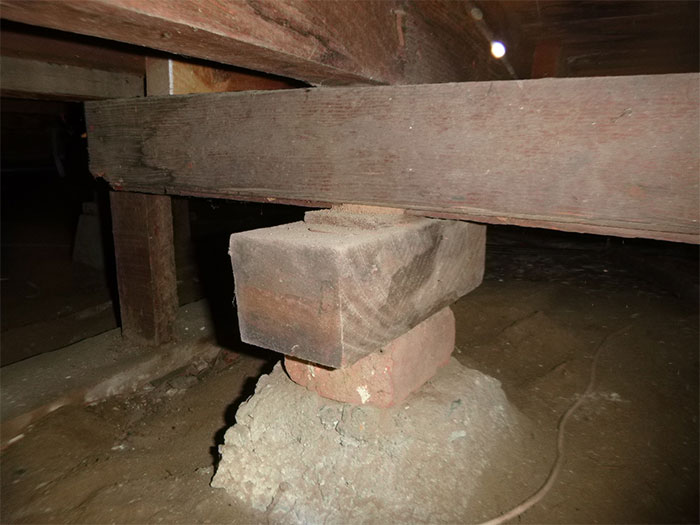
Similar to a BLT sandwich, this is a concoction of random materials used to hold up a girder! Wonderful!
dangerous-weird-things-structural-inspections
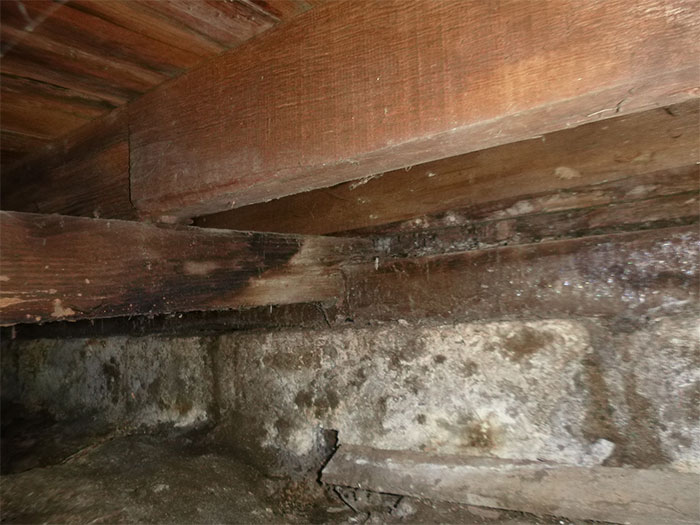
ometimes you just have to let the photo speak for itself. This is one of those photos.
dangerous-weird-things-structural-inspections
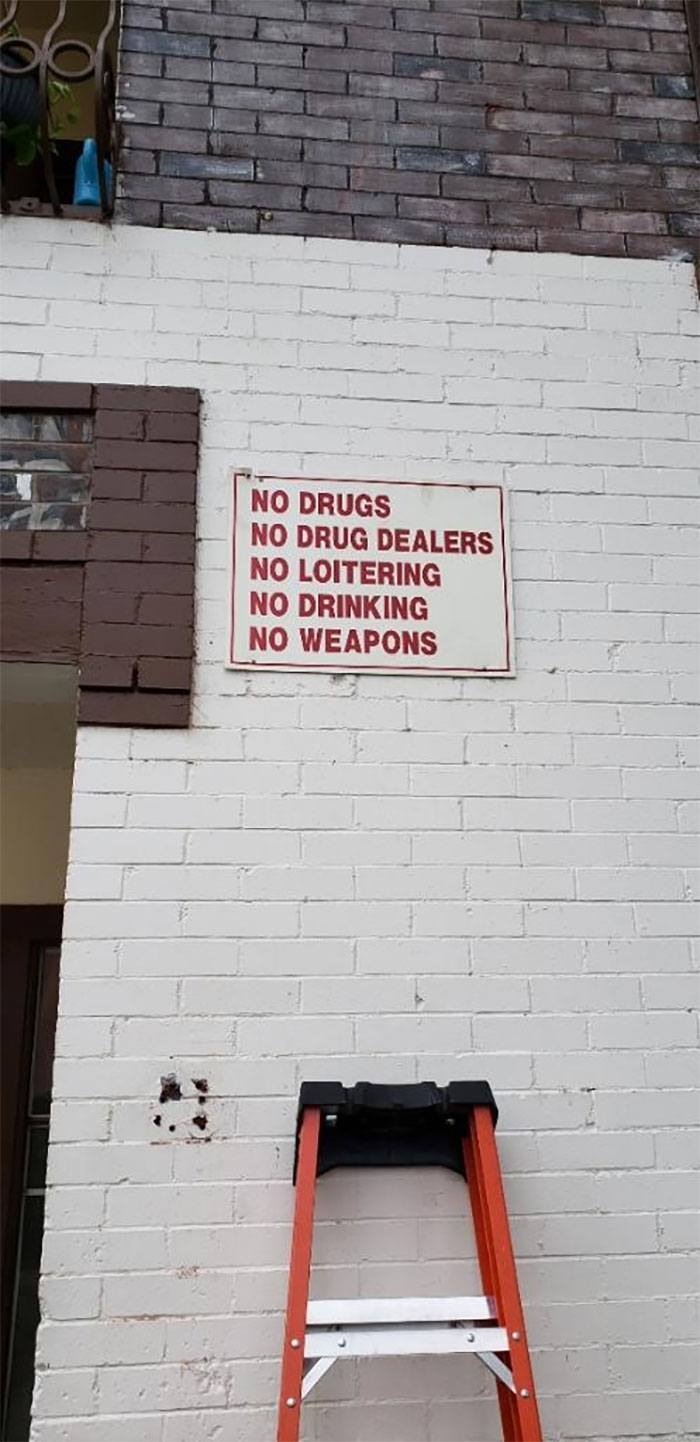
A sign seen on one of our job-sites.
dangerous-weird-things-structural-inspections
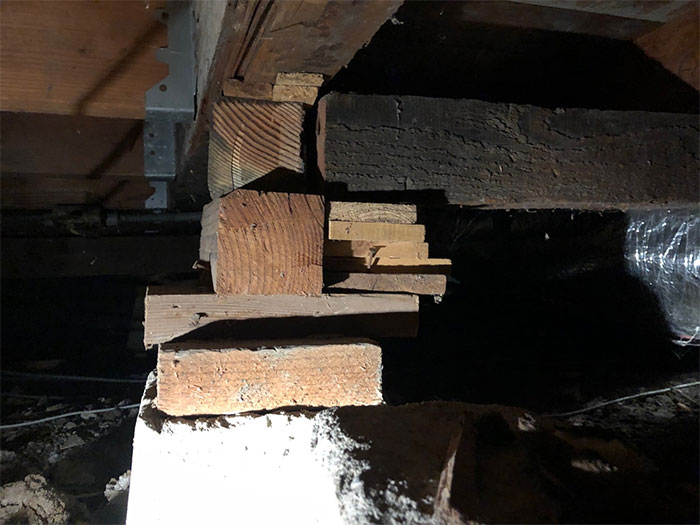
Somebody has some serious Jenga skills!
dangerous-weird-things-structural-inspections
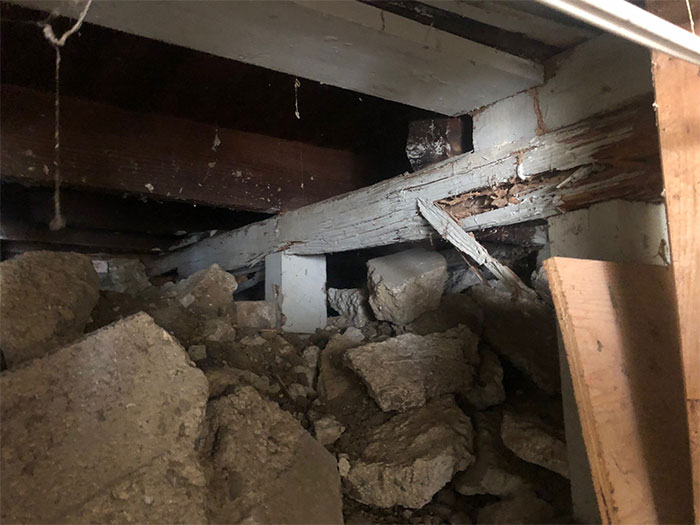
This girder was rotted to oblivion and had the actual texture of a sponge. Additionally, the old concrete foundation and other chunks of slab filled this crawlspace to the brim. Very hard to traverse.
dangerous-weird-things-structural-inspections
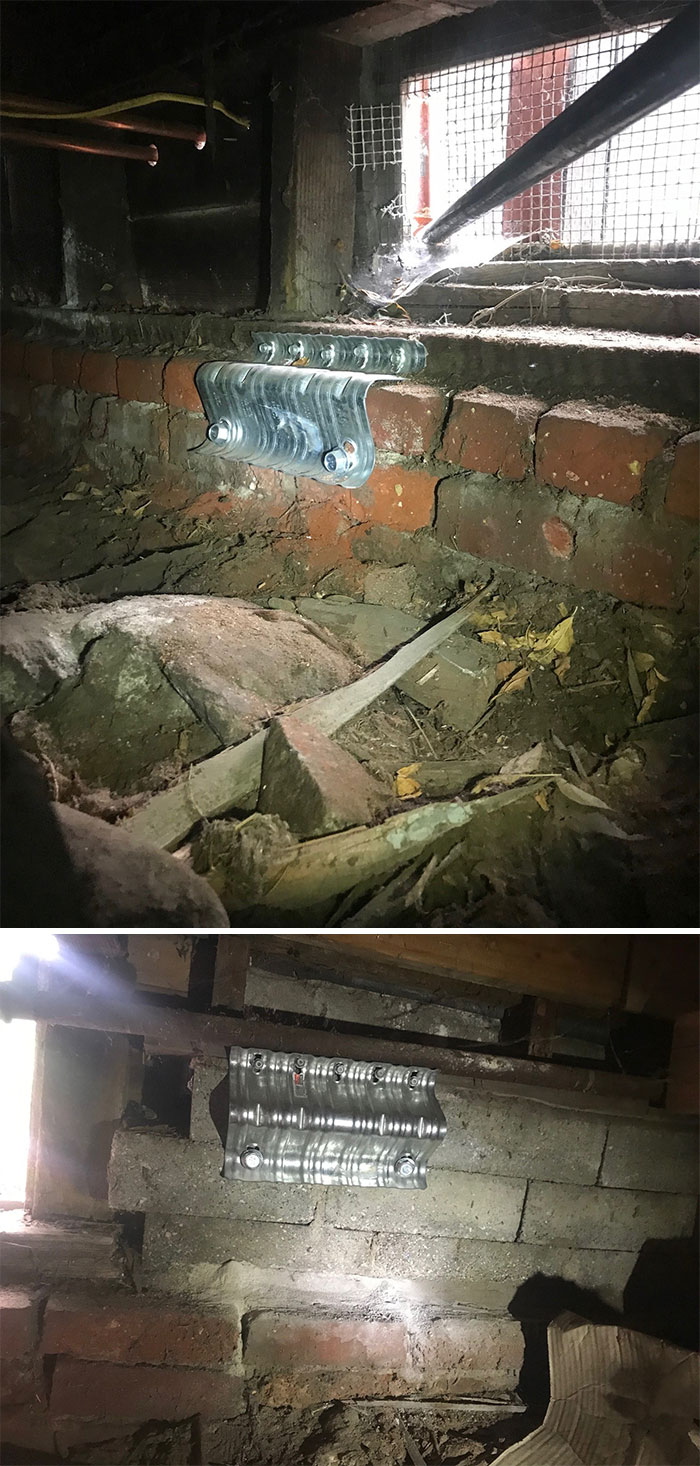
Imagine crawling under a home with a brick foundation. Okay good, now imagine those bricks could be pushed out easier than the first block in a Jenga game (that’s right… two Jenga jokes). Now these metal side anchors are specifically made to be bolted into concrete. Some other “foundation specialist” decided to retrofit this brick foundation and implement these metal plates. This was also passed by the city inspector and filed as a complete retrofit. If somebody ever tells you that they can retrofit your brick foundation, they are sorely misinformed or trying get a quick buck. This will do NOTHING to help secure your home and resist seismic activity.
I want to briefly explain this one. Again, these plates are for securing your home’s framing to the foundation. This helps stop the house from sliding off the foundation during an earthquake. This side anchor is bolted into the old mudsill and the masonry blocks above the brick foundation. Both materials that have been bolted into are old, decayed and would move with ease in a sizable quake. Another example of how not to retrofit a foundation.
dangerous-weird-things-structural-inspections
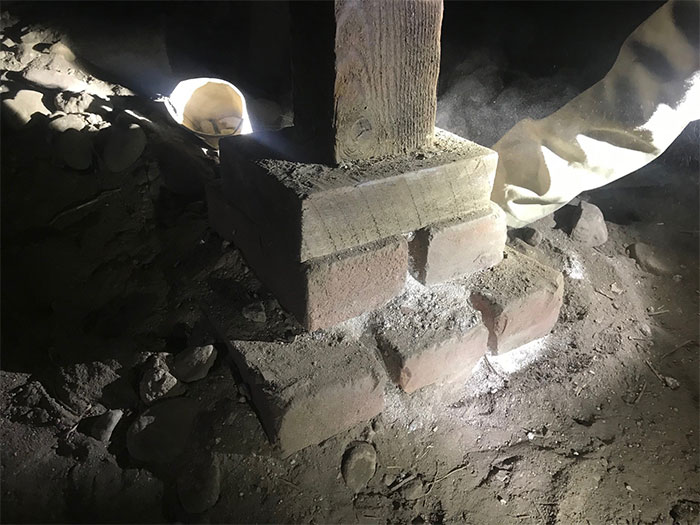
The illuminated aura around this post makes it seem like it has a quest for me.
dangerous-weird-things-structural-inspections
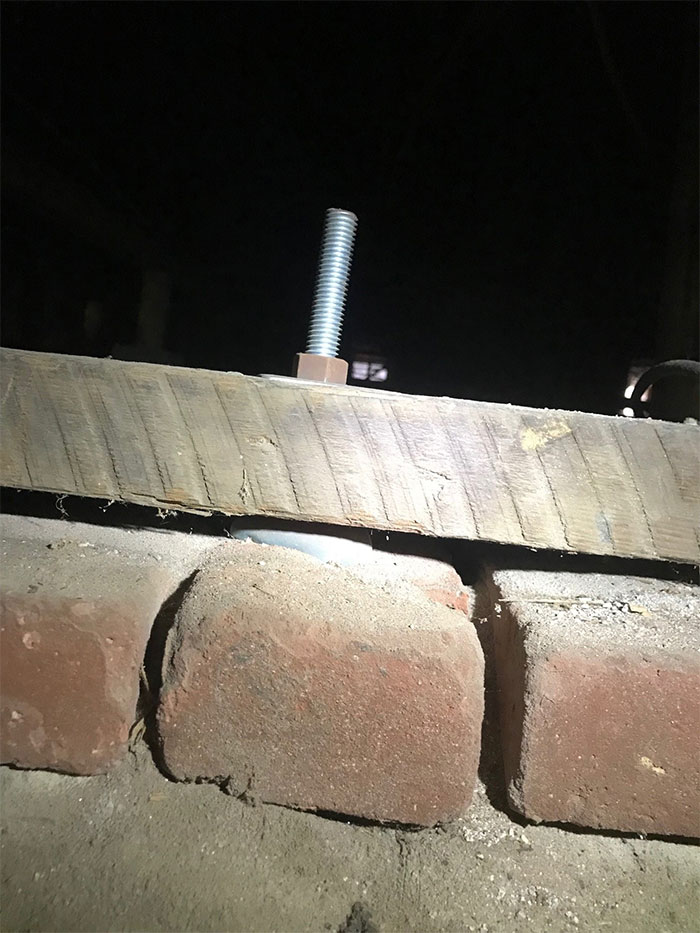
I want you guys to tell me how this being bolted makes no sense. There’s a few things here, so let me know what you think!
dangerous-weird-things-structural-inspections
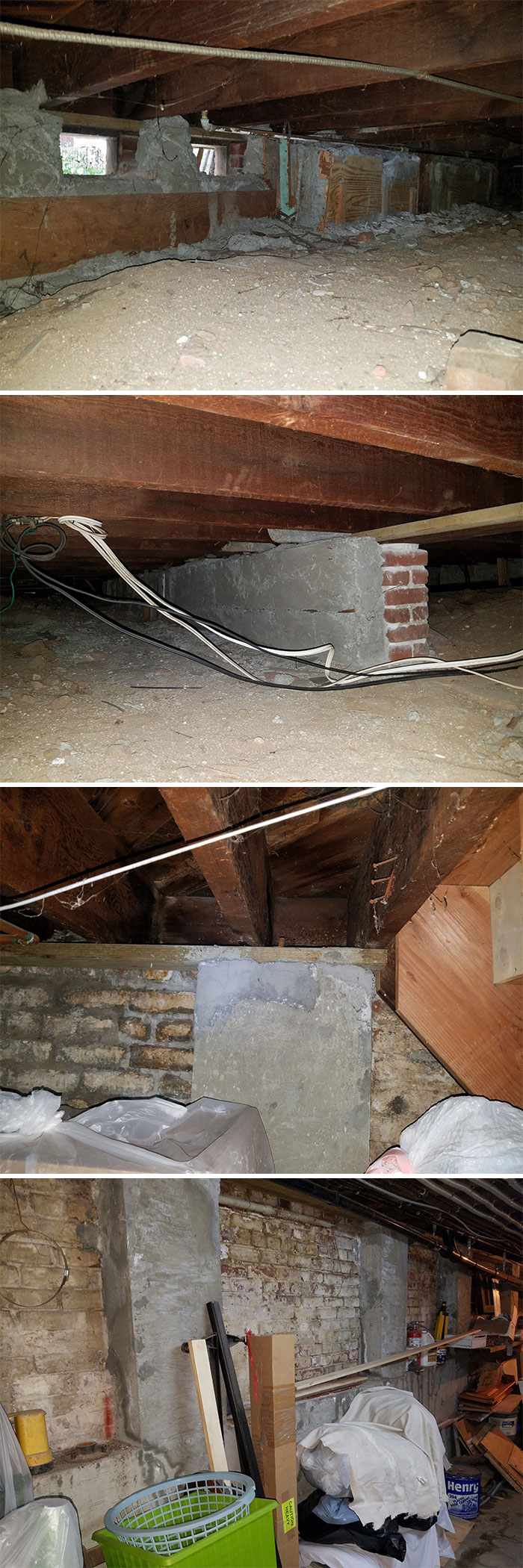
This was an attempted sister wall of an existing brick foundation. As you can see, this must have been done by a professional. Here’s another part of the foundation, this time in the middle. This was not formed correctly, there’s rebar exposed and there’s no actual connection besides the concrete drying and solidifying onto the brick. Not good.
There were also these odd, makeshift concrete pillars to help support the perimeter framing. These were bolted down but don’t really hold much structural value if the brick gives way in an earthquake.
dangerous-weird-things-structural-inspections
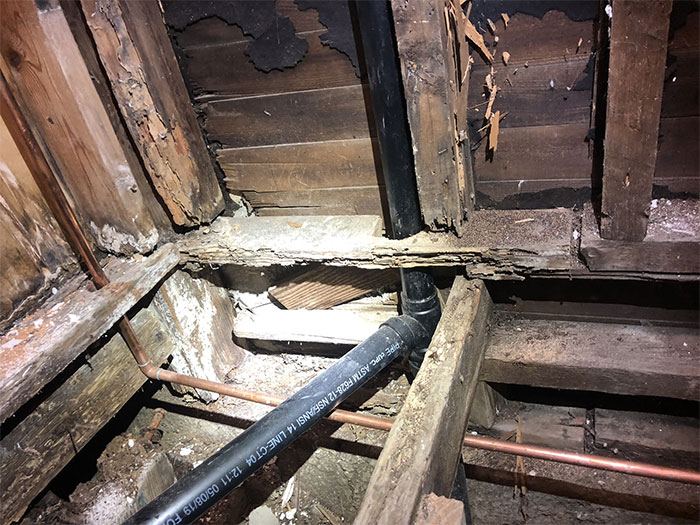
If you’ve never seen wood rot before, here you go. This is usually caused by leaking pipes or water intrusion. Termites also got a hold of it and made it worse.
dangerous-weird-things-structural-inspections
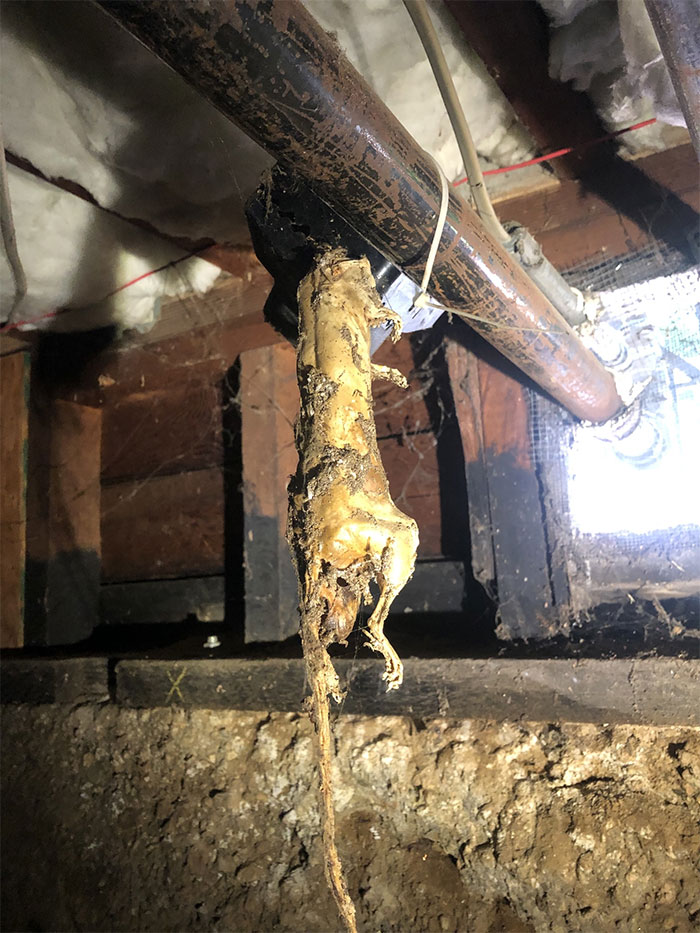
Ladies and gentlemen, we got him.
dangerous-weird-things-structural-inspections
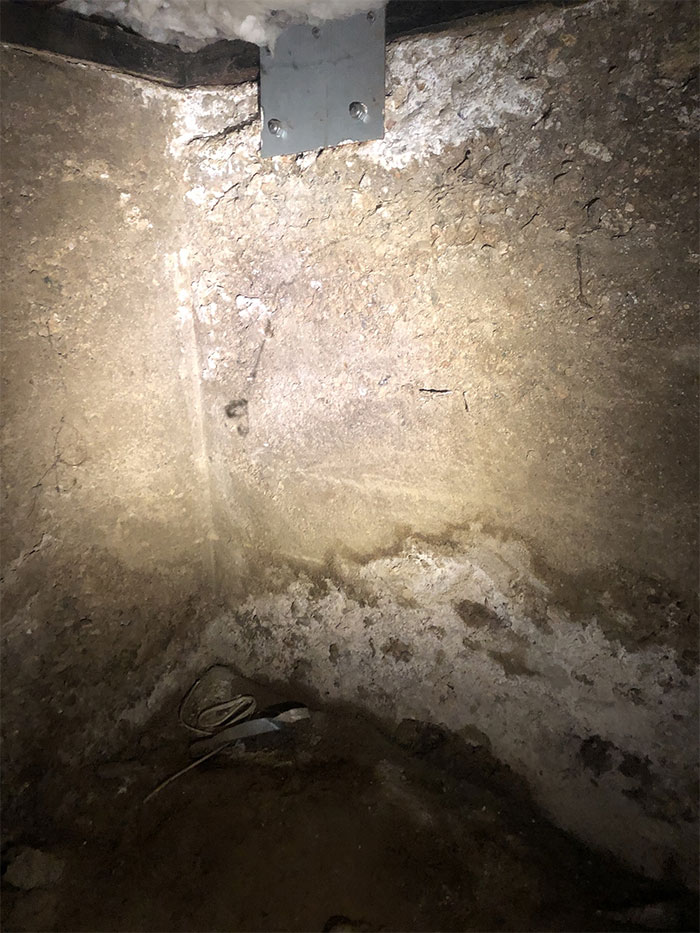
This is an older concrete foundation that is really beginning to deteriorate and crumble. It’s been seismically retrofitted but not up to code. Tons of moisture was down under the home as well, so most of the foundation was like this.
dangerous-weird-things-structural-inspections
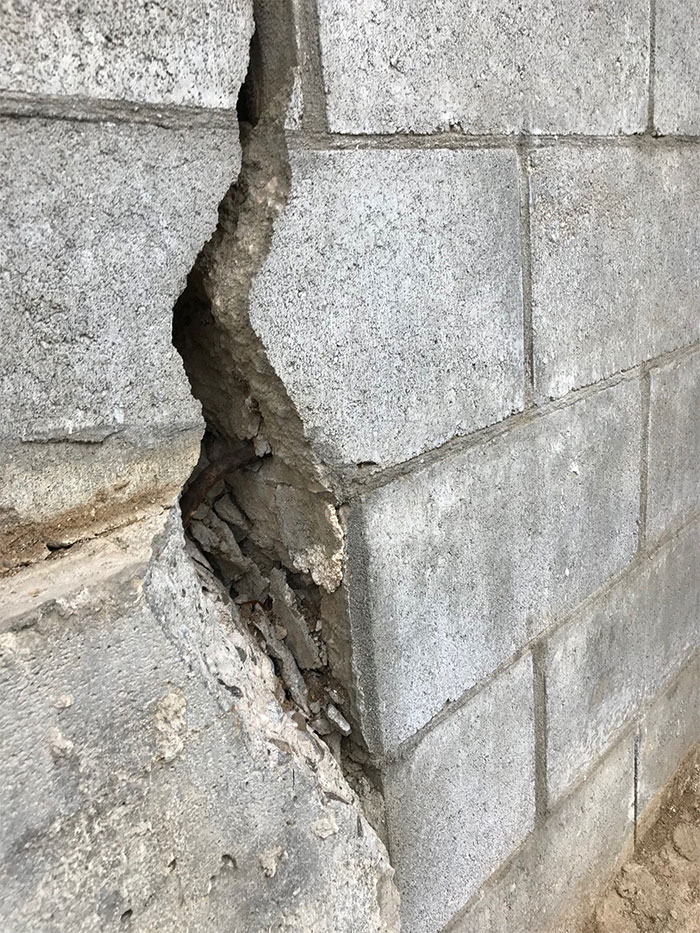
This is a retaining wall that had a massive vertical crack going right down the middle of it. You can see the exposed rebar in the hole and quite a sizable gap.
dangerous-weird-things-structural-inspections
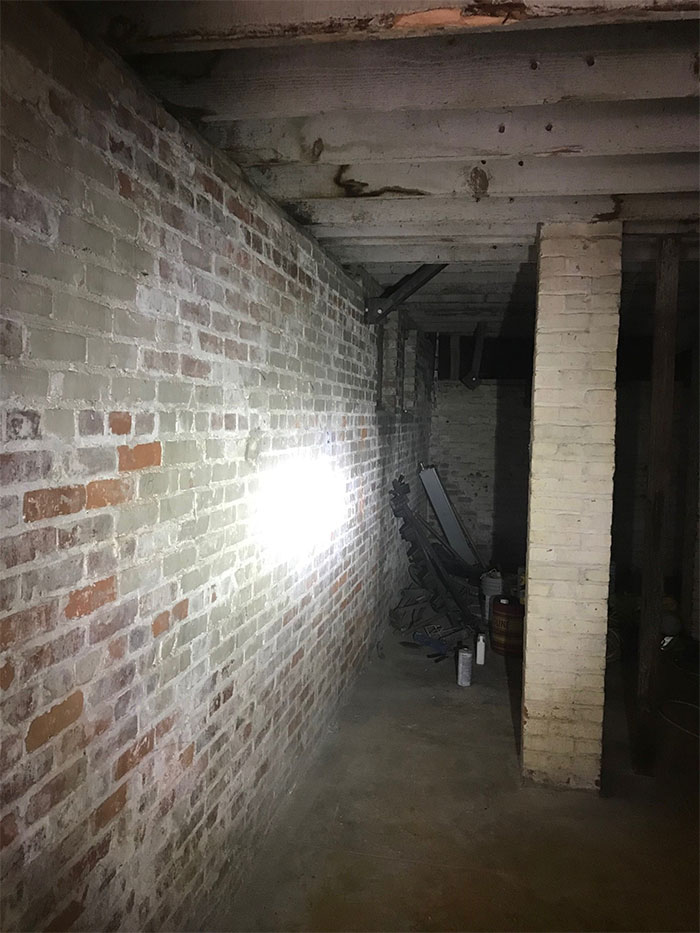
This was an 8′ tall brick foundation under an apartment building in Los Angeles. We usually recommend replacing old brick foundations, but this one actually seemed to be in decent shape. The interesting part is just how massive the wall is.
dangerous-weird-things-structural-inspections
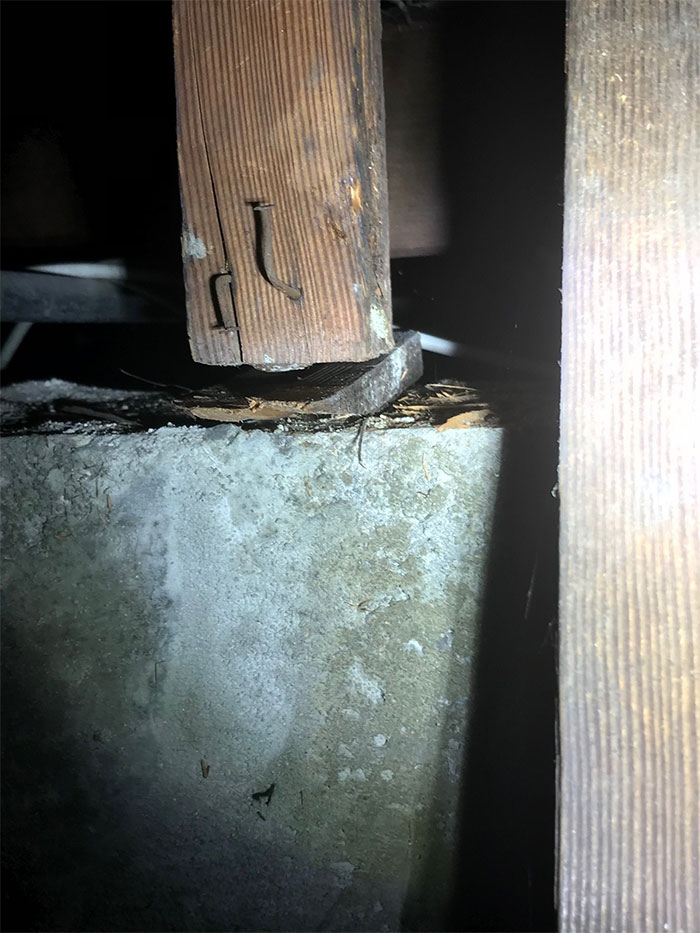
Those nails are doing a great job holding nothing together.
dangerous-weird-things-structural-inspections
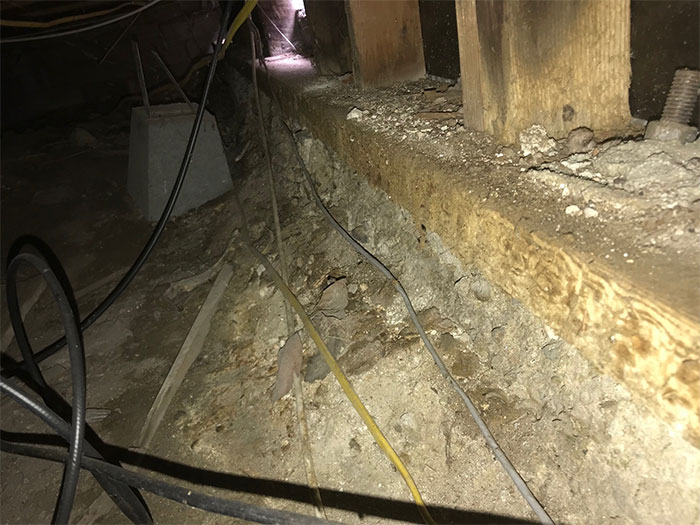
Two things here: The foundation itself is in rough shape and is badly deteriorated. Also, the anchor bolt you see to the right (used for seismic retrofits) was installed at an angle into brittle concrete. There is no point in having that bolt (which was installed in the past couple years) drilled into that bad of concrete. It does nothing.
dangerous-weird-things-structural-inspections
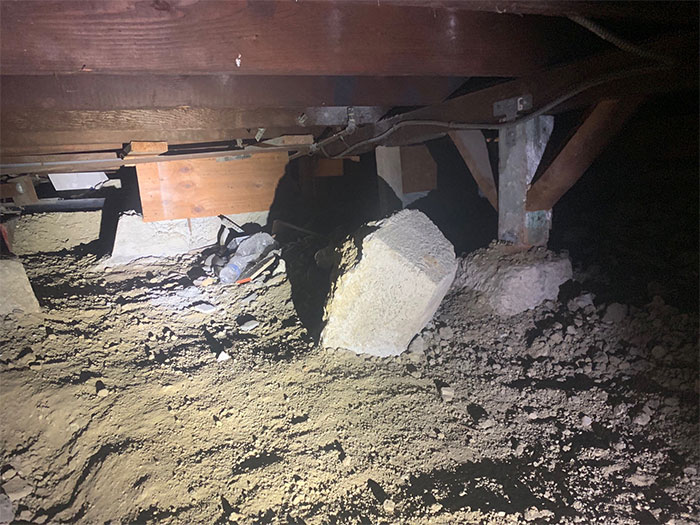
“Can you help me? I am missing my post!”
dangerous-weird-things-structural-inspections
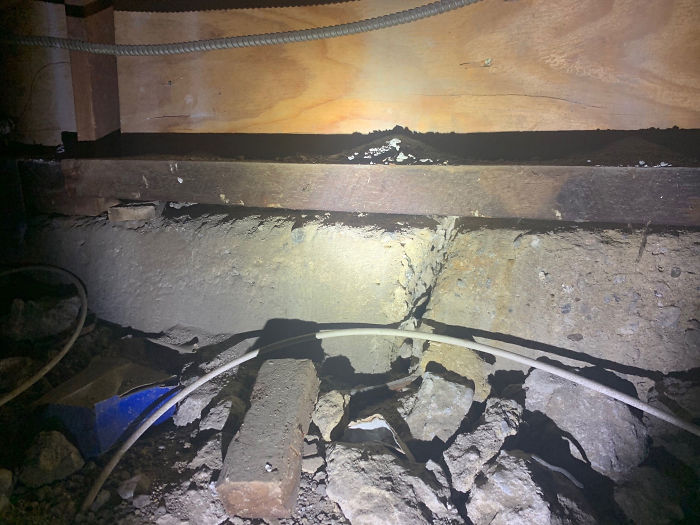
This was a sizable crack in the concrete stem wall of an old foundation. In addition to the crack, the framing of the home isn’t even making contact with the concrete.
dangerous-weird-things-structural-inspections
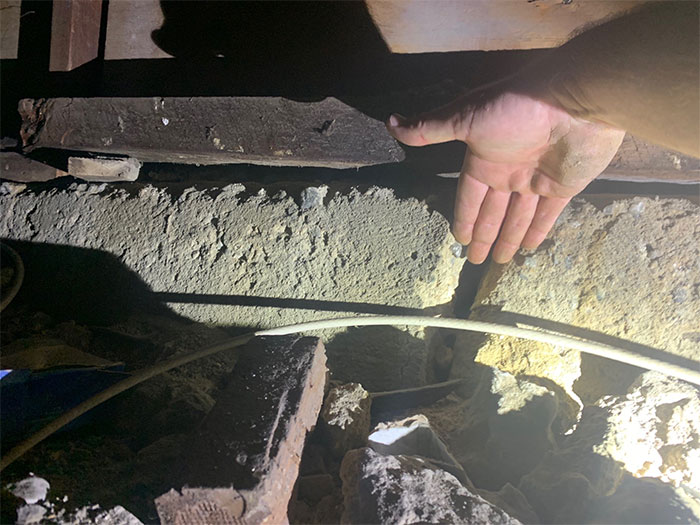
Here is another shot, just so you get the actual size of the crack.
dangerous-weird-things-structural-inspections
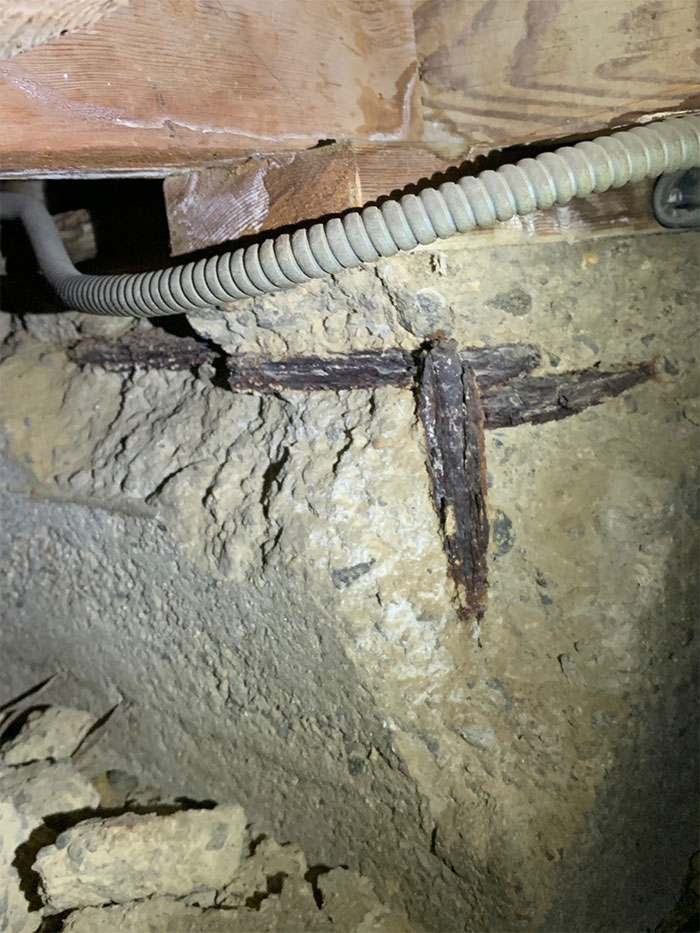
This is what we call “spall damage.” This occurs when moisture gets into the concrete from either side and the rebar inside begins to rust. This particular property in K-Town had plenty of spall damage.
dangerous-weird-things-structural-inspections
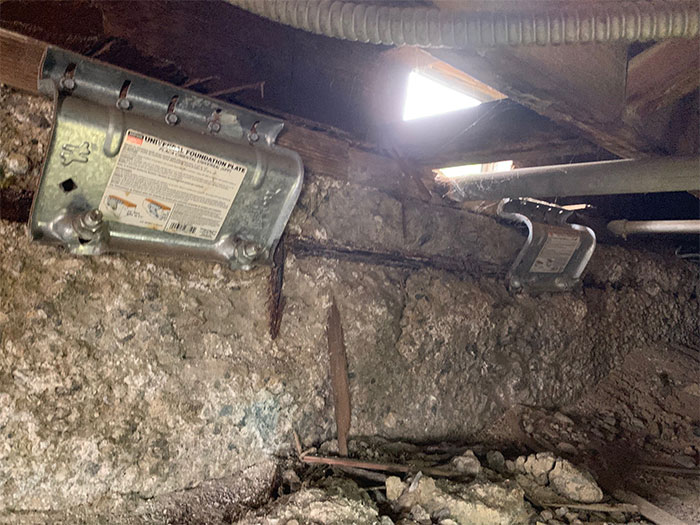
This is how not to retrofit a property. These are UFPs (Universal Foundation Plates). They are used for connecting the framing of the home to the foundation. Like I mentioned in one of the other pictures, there’s no point in retrofitting this foundation with its current condition. The concrete is over 80 years old and very brittle. Additionally, the spalling would call for a replacement of that section, which would mean that the other so called “foundation specialist” that did this was aware of the condition of the concrete and did the retrofit anyways. Some contractors just don’t have the wherewithal to do real, honest work.
dangerous-weird-things-structural-inspections

This was a property in Pasadena that had tons of these 2x4s acting as posts, which were resting on bricks. Some of them weren’t even held up by bricks, just another piece of wood on the dirt!
Here is the back house to that same Pasadena property. This whole foundation needs to be replaced. The aggregate material (rock and sand) which concrete holds together, is chipping away with ease and no bolting or other seismic upgrades could be done without the concrete cracking in half.
dangerous-weird-things-structural-inspections
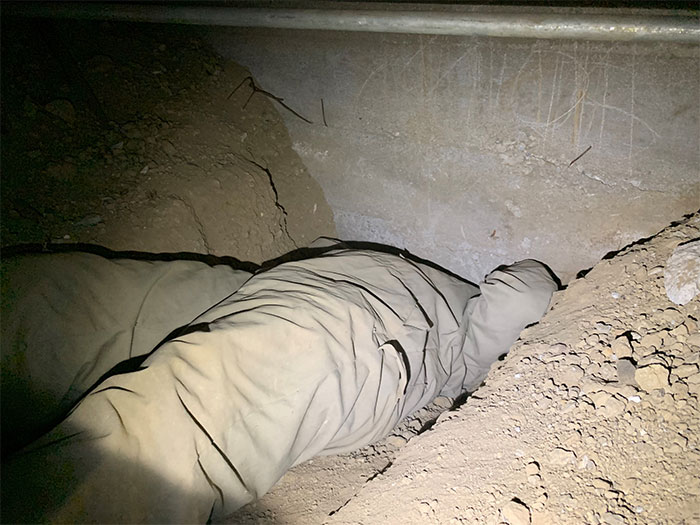
While doing this inspection there was a section of the foundation that was undermined by previous contractors. We ended up having to squirm our way under that stem-wall and come up on the other, much tighter section of the crawlspace. For those with claustrophobia, this would have been a nightmare.
dangerous-weird-things-structural-inspections
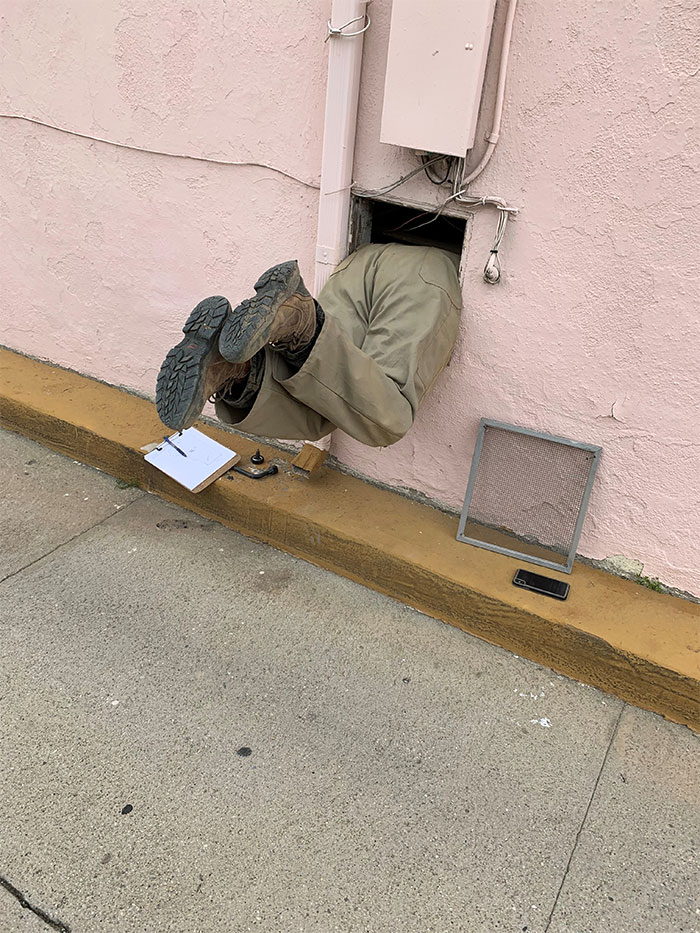
Sometimes the access points to these crawlspaces can be a bit rough…
dangerous-weird-things-structural-inspections
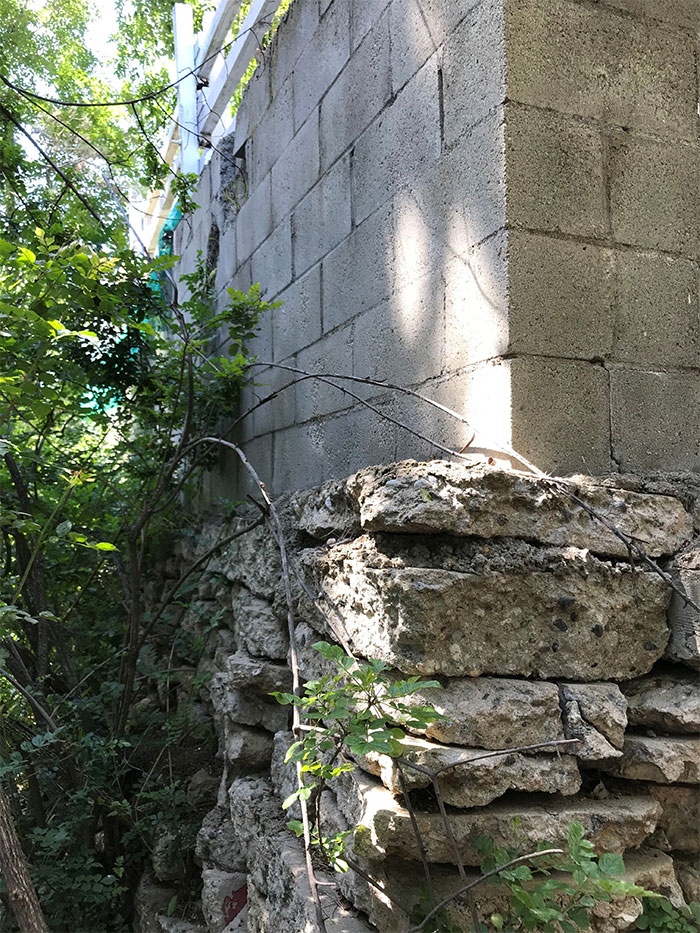
Here we have a shoddy concrete rubble retaining wall. There has since been a new masonry wall built above the old concrete rubble retaining wall. It was surprisingly sturdy.
dangerous-weird-things-structural-inspections
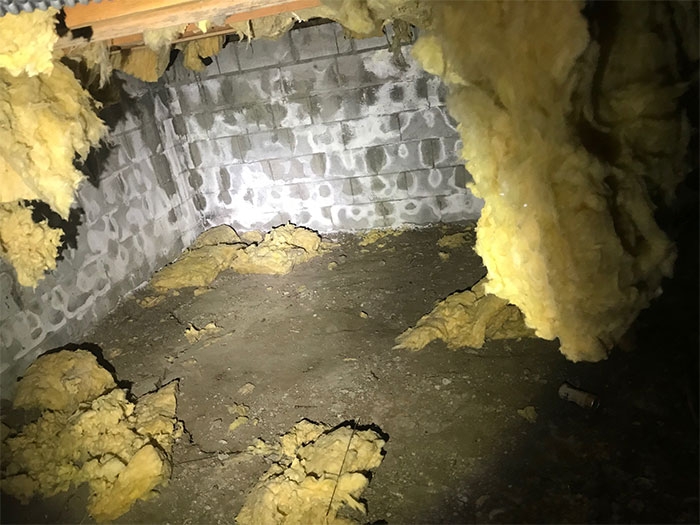
Do you see all that white, chalky stuff on the CMU foundation? That is called efflorescence. Efflorescence is caused by traces of mineral deposits and calcium build-up resulting from water intrusion. This wall was subterranean and had zero waterproofing done to the exterior. Also, free cotton candy all over!
dangerous-weird-things-structural-inspections
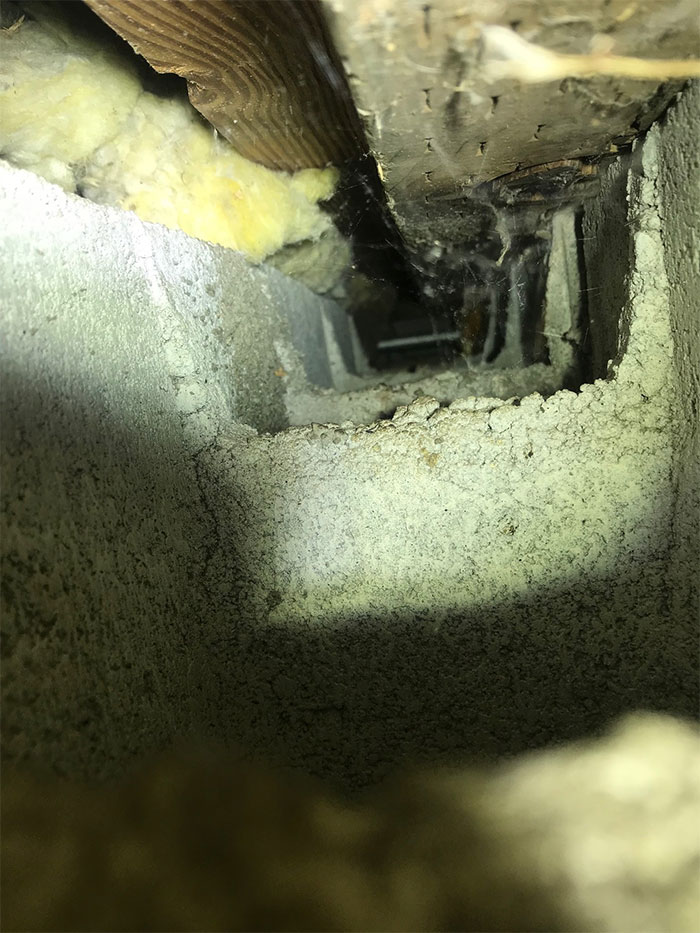
Here we have a concrete masonry foundation. Usually these are completely filled with steel reinforcement bar and concrete. This is almost always a part of city code, but this property had nothing. No concrete, no rebar… nothing. You can see the mudsill above, which is somewhat hanging over the hollow foundation.
dangerous-weird-things-structural-inspections
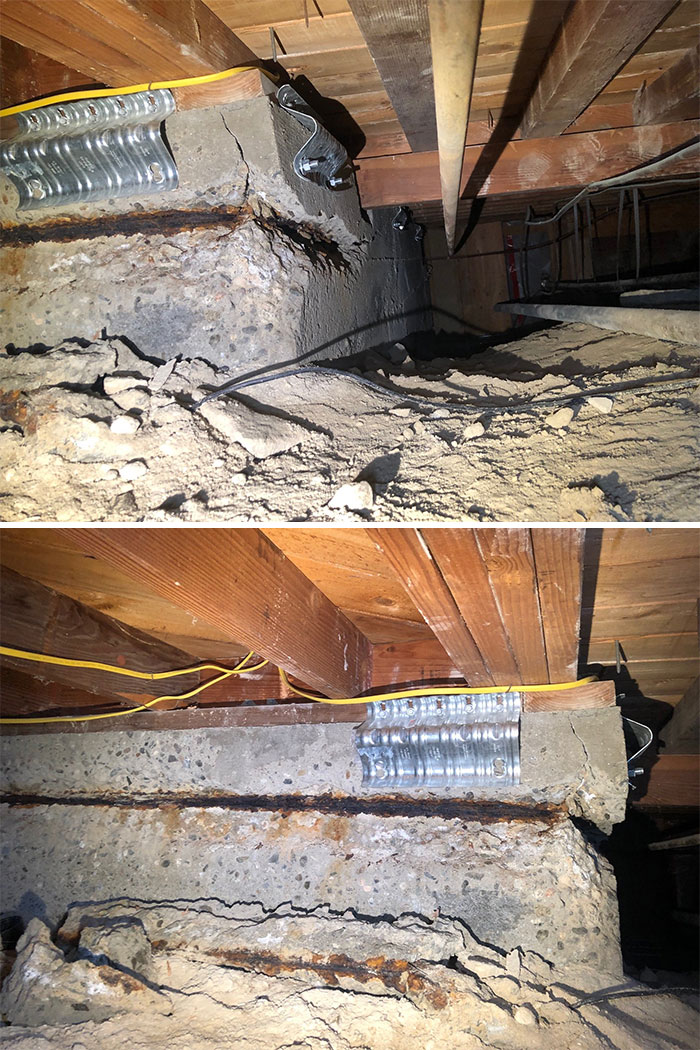
Image 1: There is very bad spall damage on many areas of this foundation. Spall damage is when water gets into the concrete and causes oxidation in the steel rebar. This causes the steel to expand and breaks the concrete around it.
Image 2: If you look close at the steel UFP (Universal Foundation Plate used for seismic retrofitting) you can see that there are bolts missing from the bottom. Which means that it isn’t bolted into the foundation and is useless.
dangerous-weird-things-structural-inspections
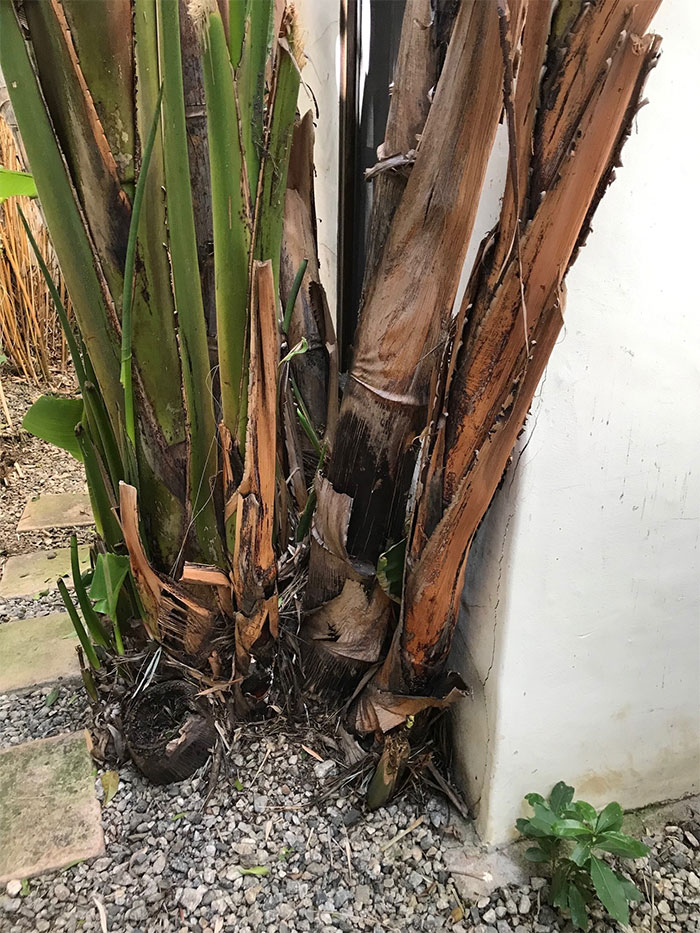
This is a bird-of-paradise plant. A very beautiful but destructive plant from South Africa. These plants, if next to a structure, can make its way under a property and lift the entire foundation. That was the case with this particular home. Nature 1, homeowner 0.
dangerous-weird-things-structural-inspections
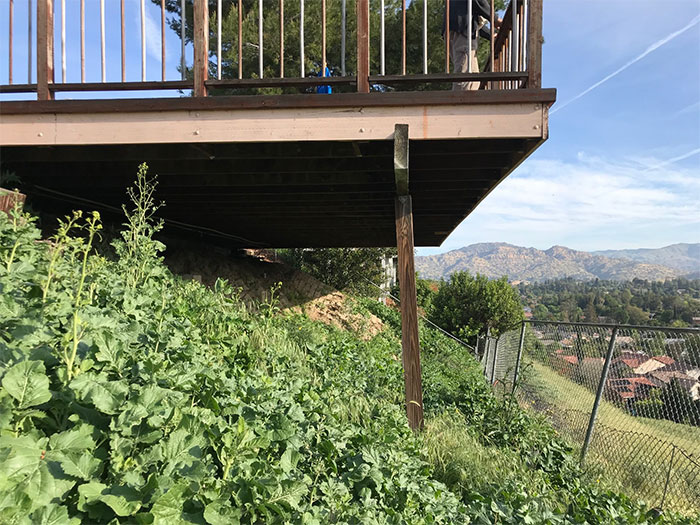
A hillside deck with some inward leaning posts. I would not want to be that guy up top.
dangerous-weird-things-structural-inspections
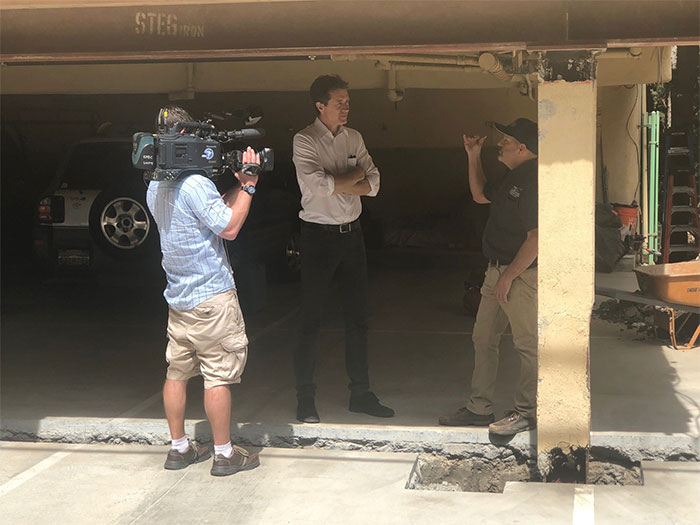
This isn’t crazy or anything but we were interviewed by ABC 7 LA on seismic retrofitting of apartment buildings.
dangerous-weird-things-structural-inspections
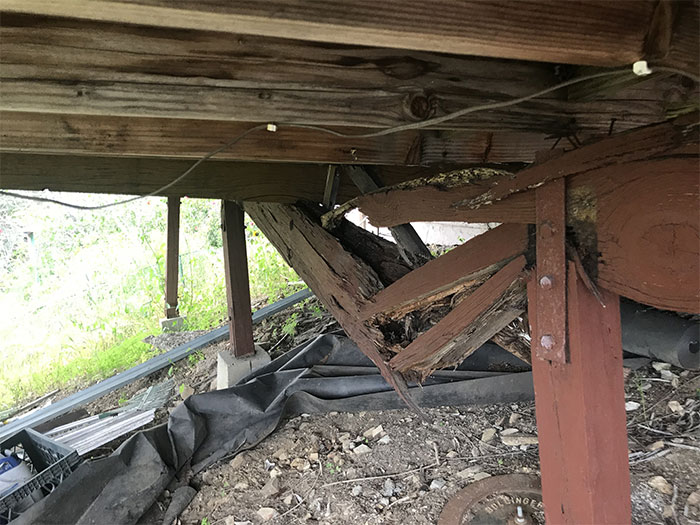
This was a hillside deck that had rotted and been damaged by termites over many years. The result is a decayed, unstable and leaning deck that is ready to slip.
dangerous-weird-things-structural-inspections
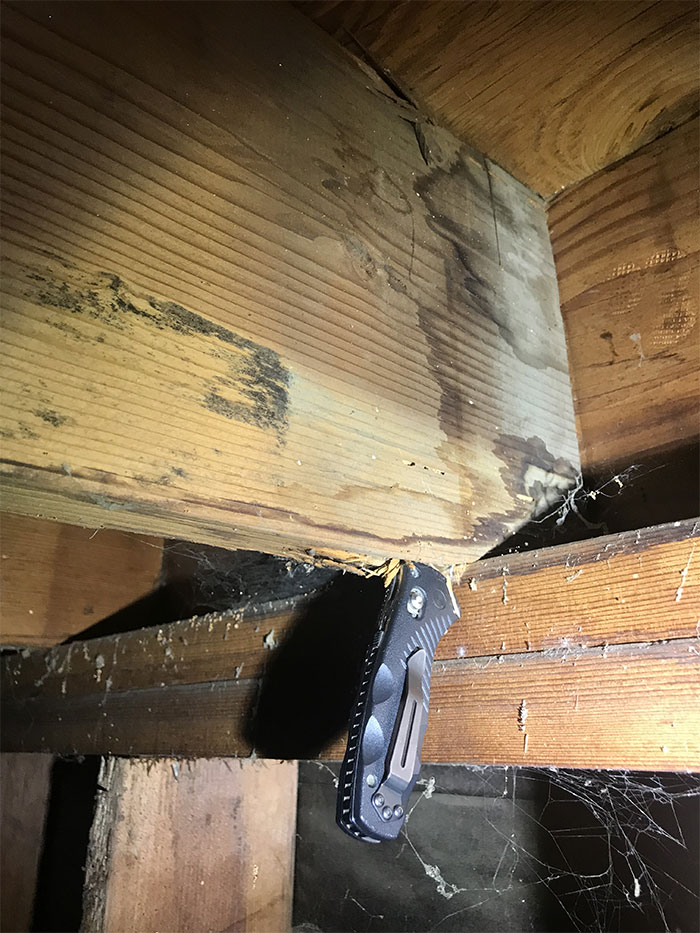
Many people will call us out to check why their floors/home is leaning and sloping. It could be settlement or missing structural elements, but half the time it’s caused by rotting supports under the home. Things begin to decay due to water intrusion and termite damage, which results in some serious issues down the road.
dangerous-weird-things-structural-inspections
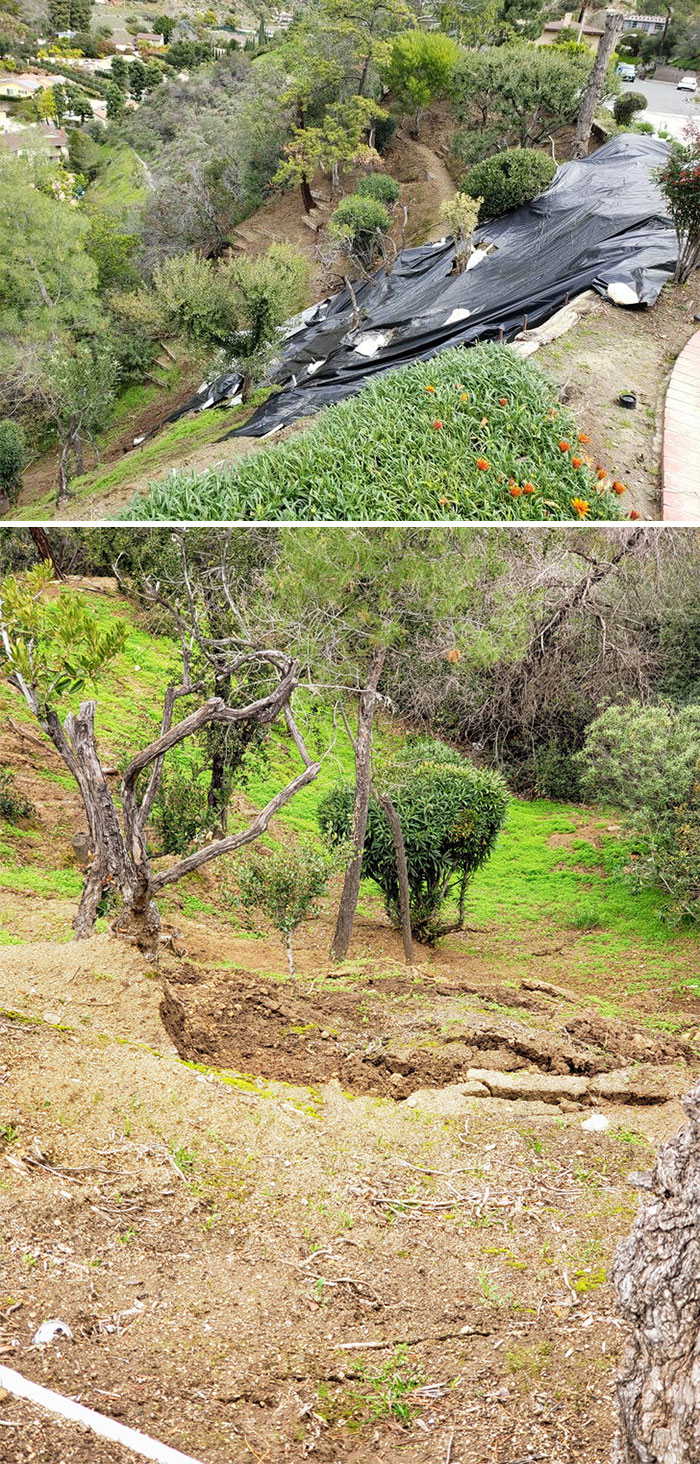
This is a landslide that occurred on a steep slope in Glendale, CA. As you may or may not know, it rained like crazy this past winter in Los Angeles. This caused many unstable hillsides to erode and mudslides were very prominent.
dangerous-weird-things-structural-inspections
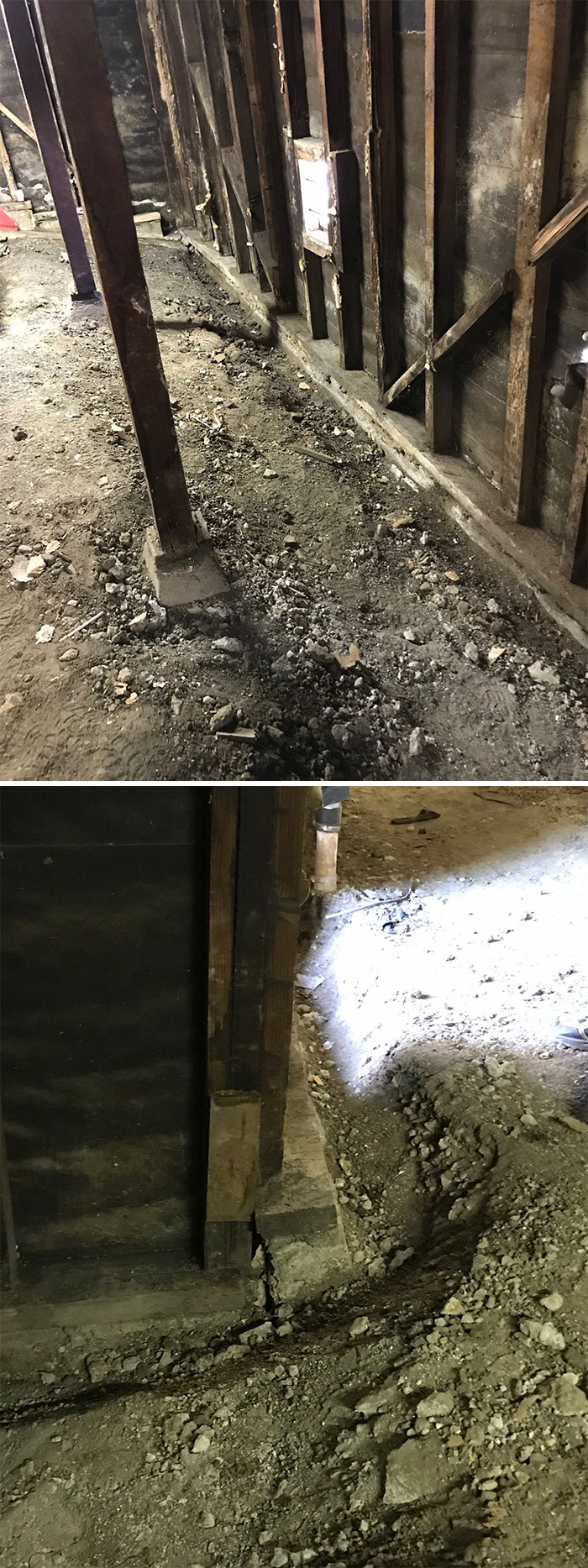
This was a very old foundation we inspected in LA. Almost every post/stud down there would crumble with the slightest scrape from a knife.
This is the same property where a section of the concrete foundation was cracked in half and was displaced from the rest of the wall.
dangerous-weird-things-structural-inspections
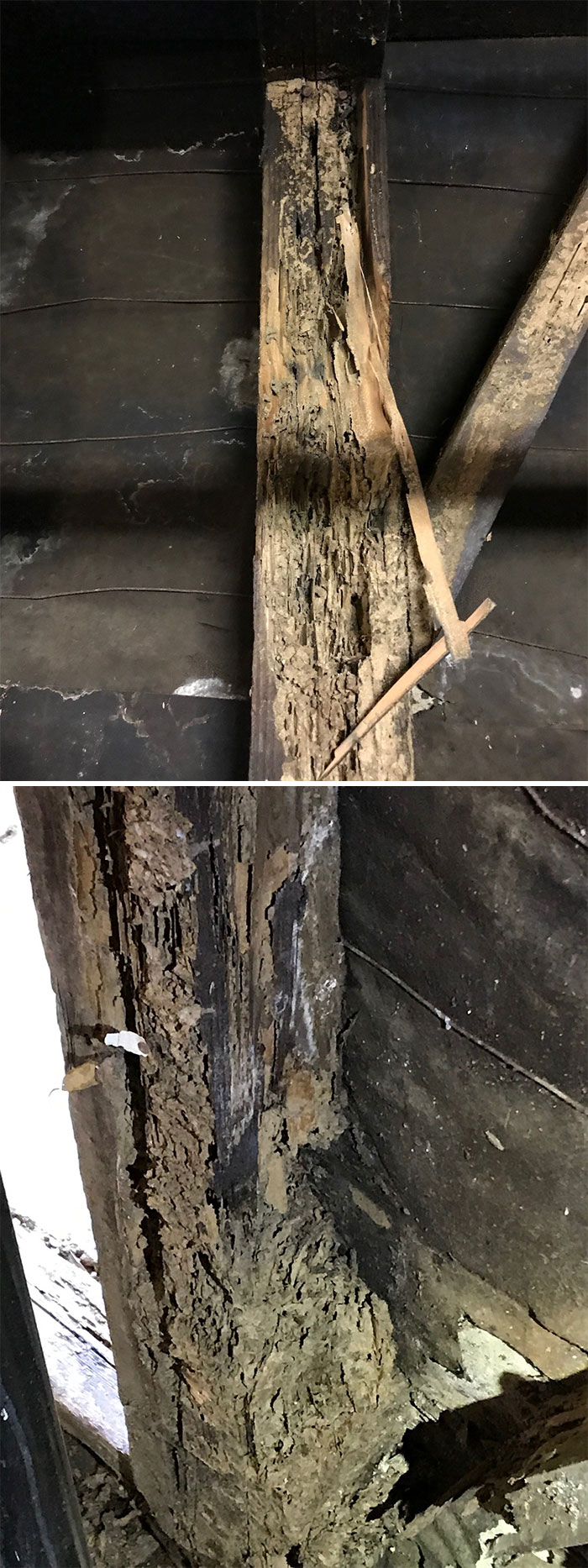
Would you feel safe with framing like this holding up your home? Me neither.
This is pretty common in older homes around Los Angeles. Years of water damage and those pesky termites will eventual cause some pretty bad rotting and instability.
dangerous-weird-things-structural-inspections
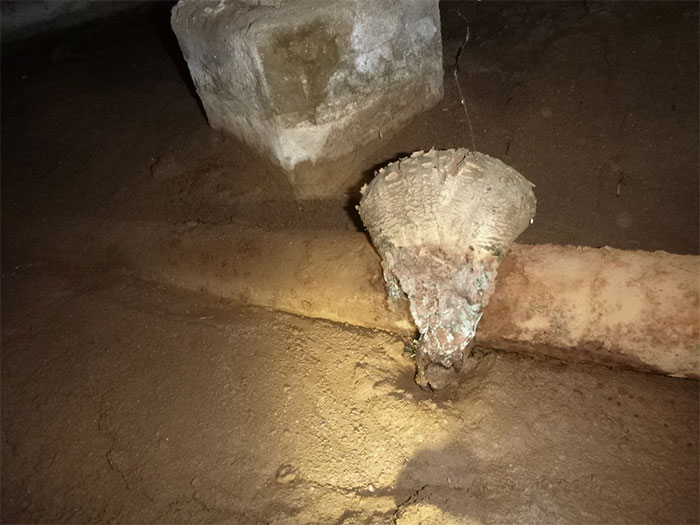
Took me a while to realize what this was.
dangerous-weird-things-structural-inspections
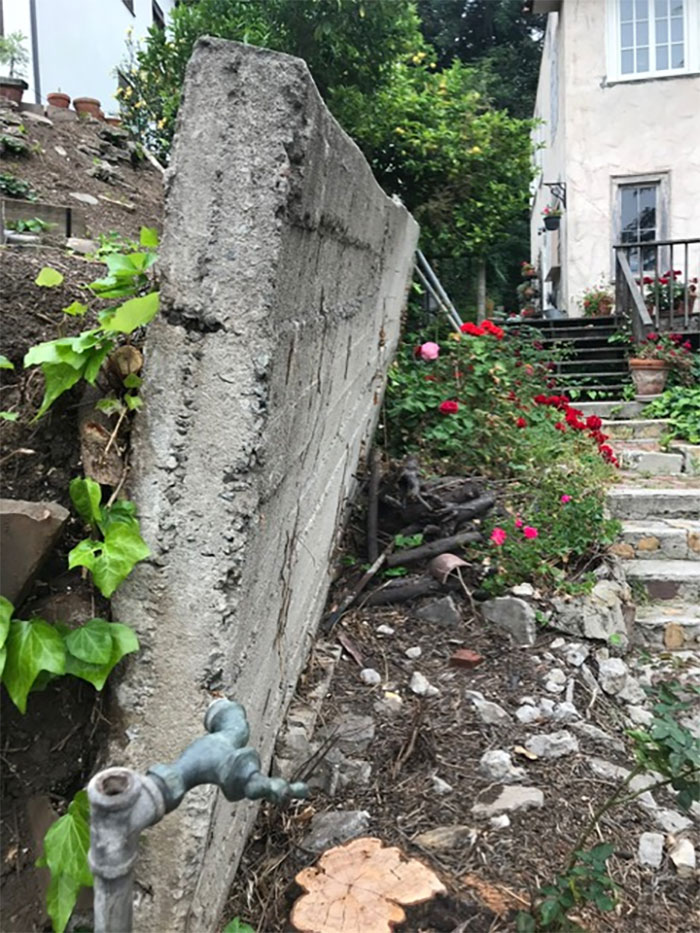
This was a pretty old retaining wall that has just about seen its final days. It will have to be replaced for sure!
dangerous-weird-things-structural-inspections
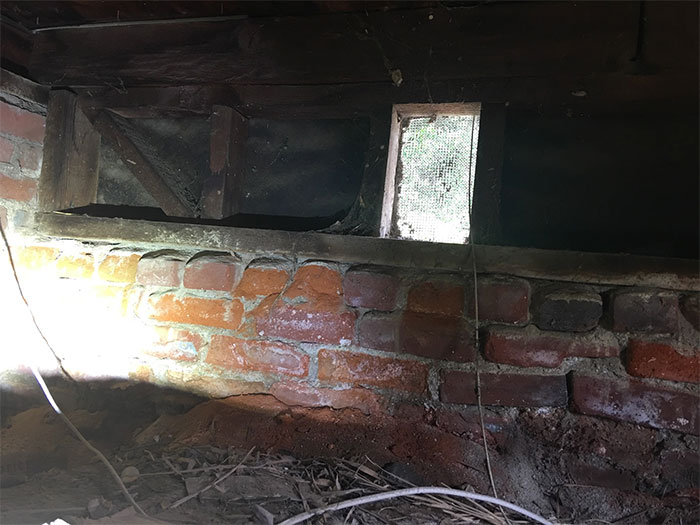
I call this foundation the “Thanos Foundation” because it has turned into dust. I bet the builder thought this wouldn’t go through the gauntlet of nature’s weathering process, but it did. I hope you understand and enjoy my terrible Marvel references.
dangerous-weird-things-structural-inspections
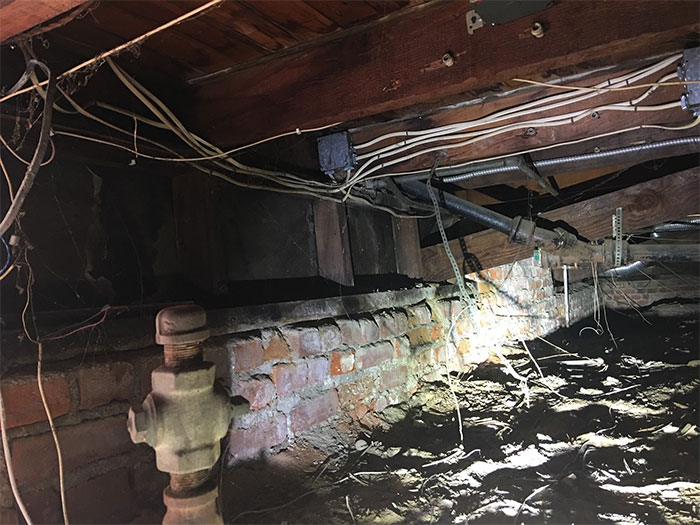
No bolting/retrofitting will be possible due to the fact that it is made of brick. This whole foundation will need to be replaced.
dangerous-weird-things-structural-inspections

We inspected this house that had some pretty bad fire damage from a recent blaze. Much of the underside of the home was torched and needed to be completely replaced. There is some good news: termites are similar to humans in a sense that they don’t like burnt food. This was the underside of the deck with a charred platform to walk on. Watch your step, you might fall through!
dangerous-weird-things-structural-inspections
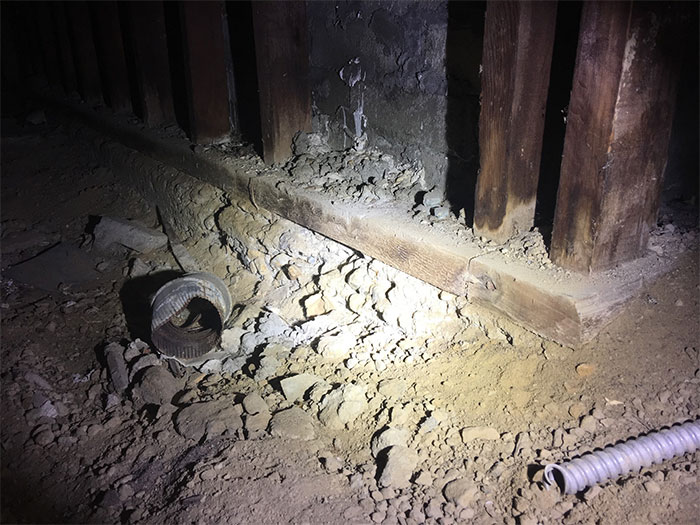
This is a 100-year-old foundation that is in need of a solid replacement. It has no retrofitting, plenty of water damage and earth-to-wood contact.
dangerous-weird-things-structural-inspections
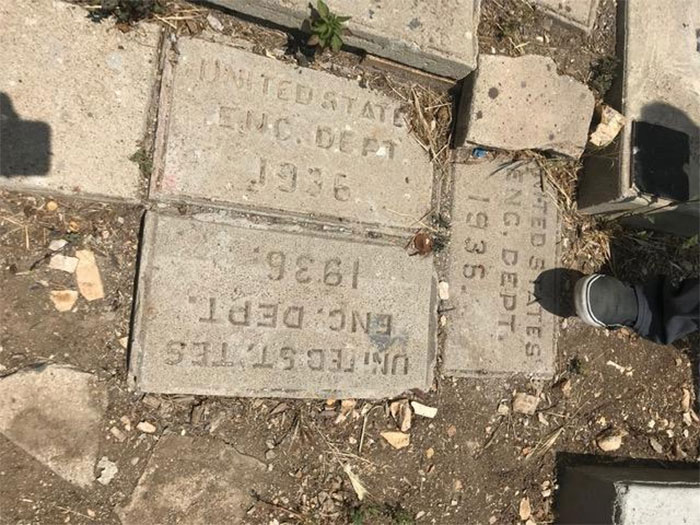
These were some very old U.S.E.D. engraved blocks that we found during an inspection of a property in LA. It’s hard to even know what that department was back then because there is very little record of it online. If anybody has more data on that, I would love to hear it!
dangerous-weird-things-structural-inspections
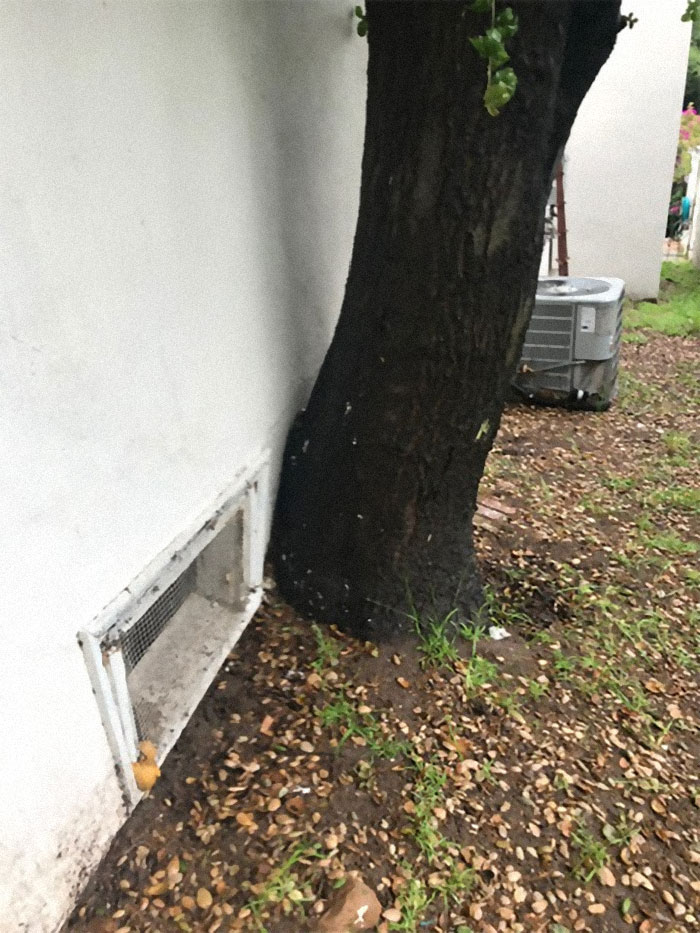
Never plant oak trees next to your foundation… It will cause nothing but issues. They are a protected tree as well and it can take a whole lot of back and forth with the city to deal with them.
dangerous-weird-things-structural-inspections
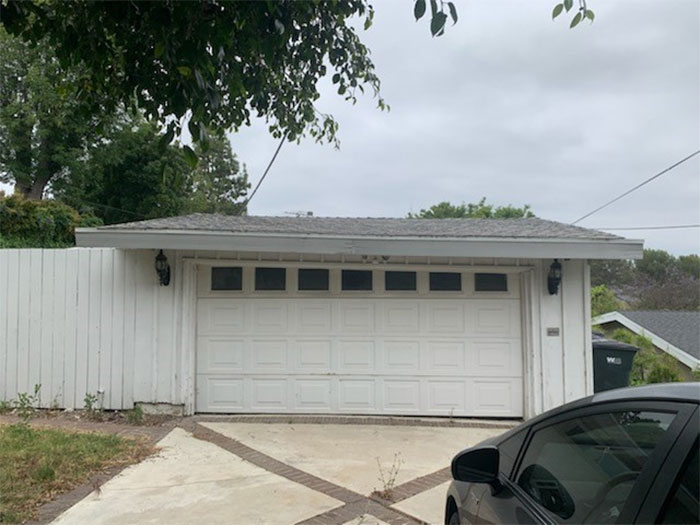
Straight as a worm in water.
dangerous-weird-things-structural-inspections
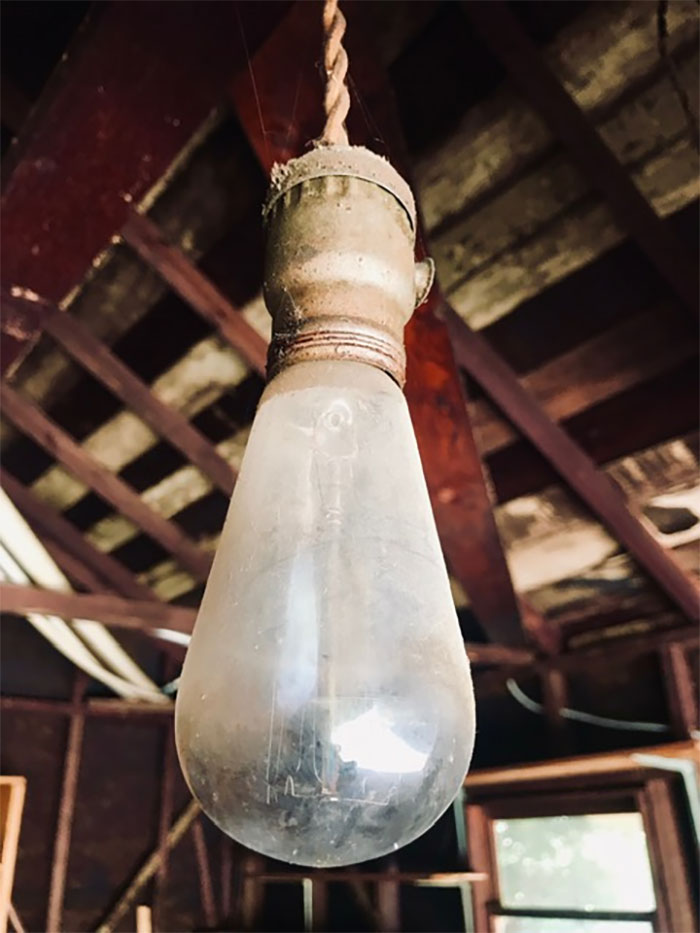
This was an old light bulb found in the attic of an old 1910 home. Nothing structural but something cool nonetheless.
dangerous-weird-things-structural-inspections
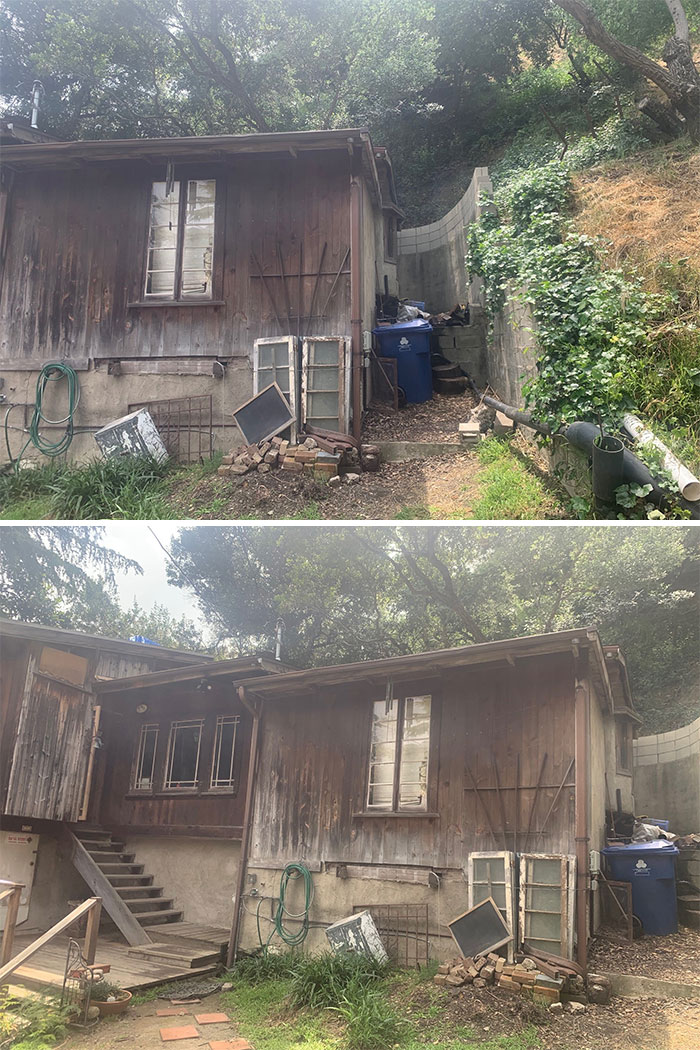
This was a very old cabin-like property in Benedict Canyon. It’s practically going back in time. Over 100-years-old and has some pretty crazy things going on. Since the property was very old and somewhat neglected, the exterior was the first sign it was gonna be an interesting one.
dangerous-weird-things-structural-inspections
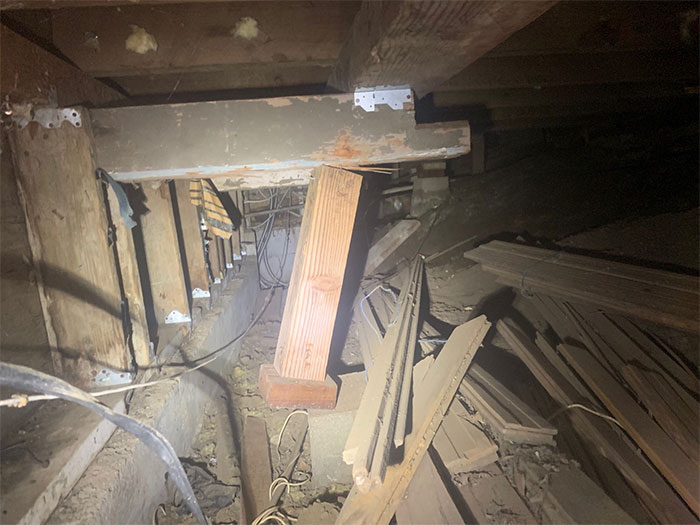
There had been some foundation work done within the last 10 years, but nothing crazy.
dangerous-weird-things-structural-inspections
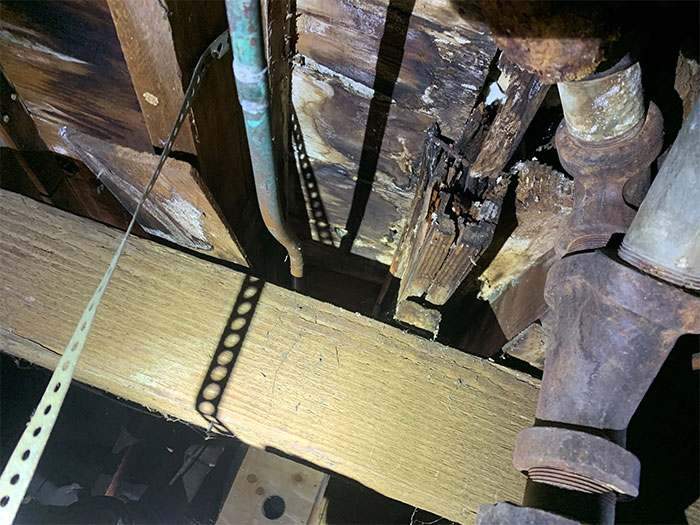
There was definitely a lot of rotting wood throughout the crawlspace and sub-floor areas.
dangerous-weird-things-structural-inspections
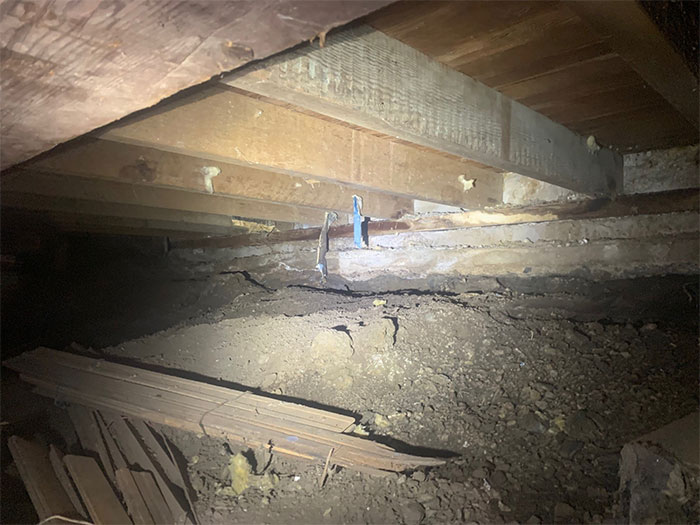
There were more than a few missing post & piers down there and the concrete itself was pretty brittle and easy to break apart.
dangerous-weird-things-structural-inspections
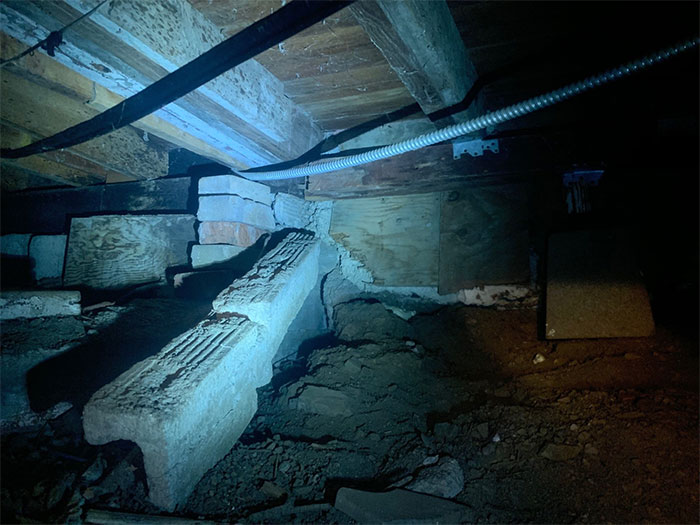
There’s a lot going on in this particular photo. You can see that the end of the girder is being held up by a stack of masonry blocks, the concrete foundation seems to be fused with plywood sheathing and there’s a line of masonry blocks waiting for their turn to help out.
dangerous-weird-things-structural-inspections
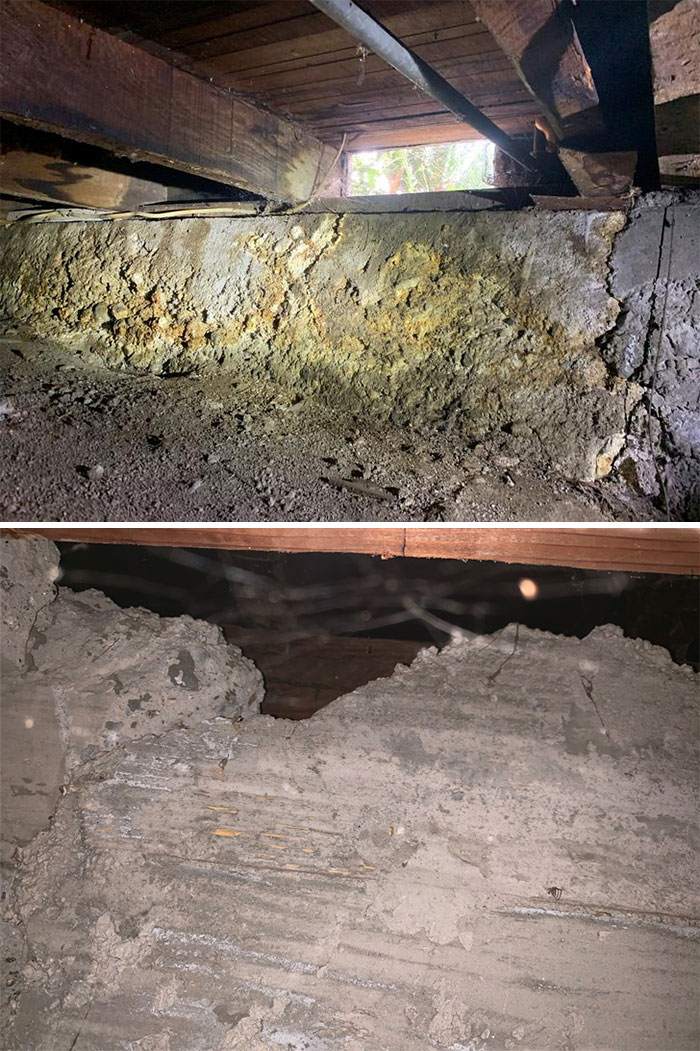
Most of this concrete foundation was brittle and crumbling to bits. Tons of efflorescence was present and cracks were all over. Additionally, part of the foundation had a sister wall next to it. A sister wall is a brand new stem wall that is tied into the existing concrete foundation. This was recently done and the concrete itself was in good shape, but the way it was formed had to have been done by a true amateur. There were gaps, honeycombs and cracks all over the new wall. There’s no way this was done with a permit.
dangerous-weird-things-structural-inspections
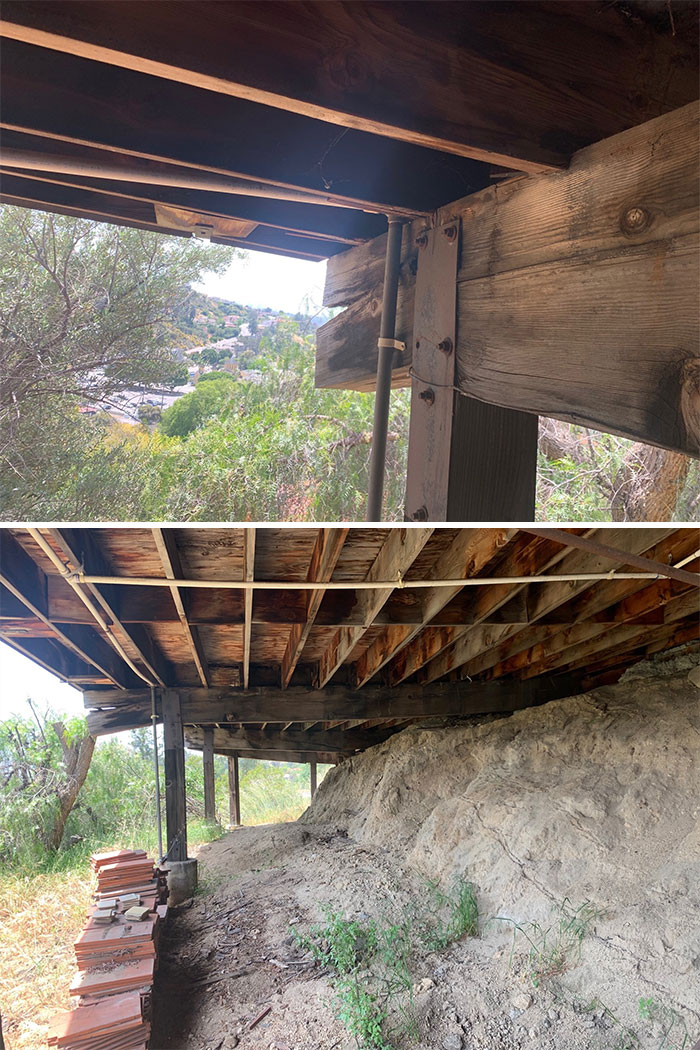
This was a very large hillside deck that had some bad rotting on some of the supporting girders. The deck itself wasn’t in horrible shape, but termites were beginning to destroy most of the girder supports.
dangerous-weird-things-structural-inspections
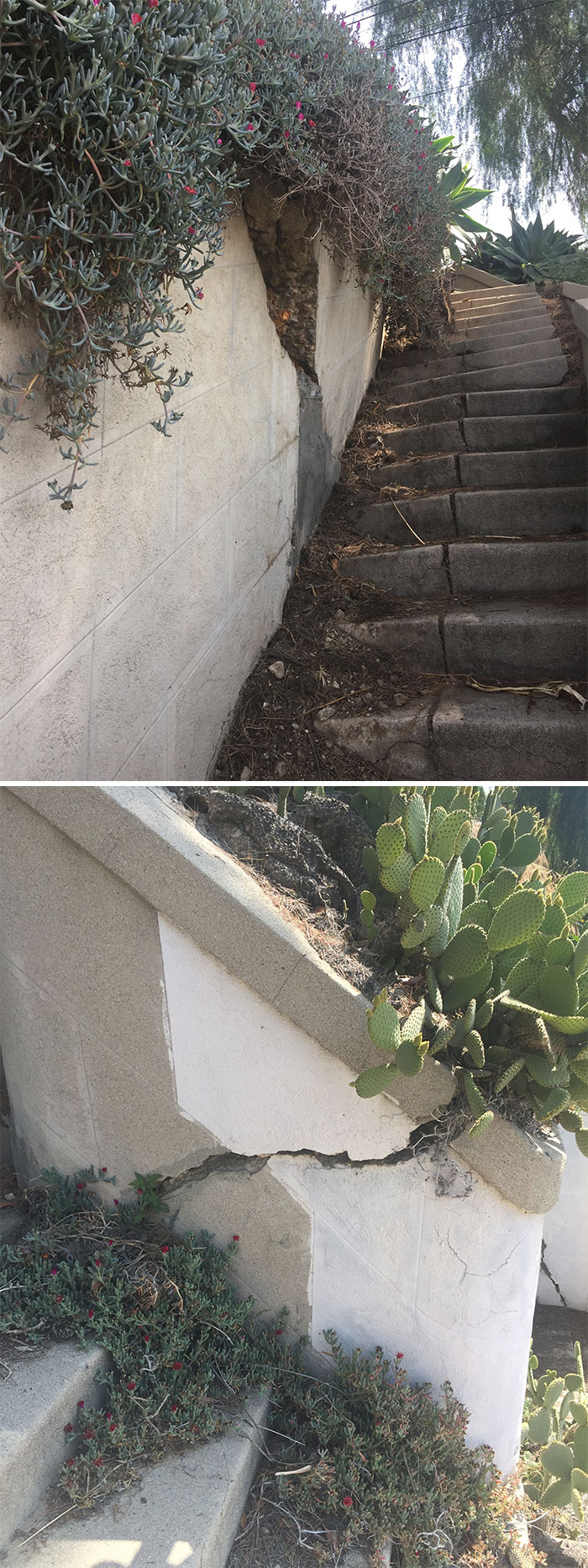
This is a wall that we will be replacing later this year. There was a serious lack of supporting footings on this staircase and retaining wall. Rainstorms and soil erosion slowly made the topsoil very unstable and caused the retaining wall & stairs to crack and slip.
dangerous-weird-things-structural-inspections
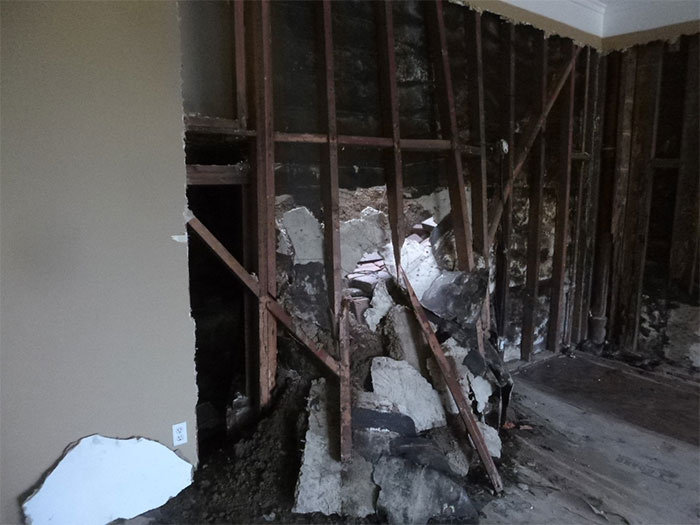
The saturated hillside burst through his wall during a remodel and caused some serious damage.
dangerous-weird-things-structural-inspections

Possibly the best earthquake safety/prevention I’ve seen so far. Also looks like the middle bin is a spider and is telling secrets to the other bins in the corner.
dangerous-weird-things-structural-inspections

These are two elements of a home that should not be separated the way the are. Not only is it missing bolts, but it has a gap bigger than the Grand Canyon.
dangerous-weird-things-structural-inspections
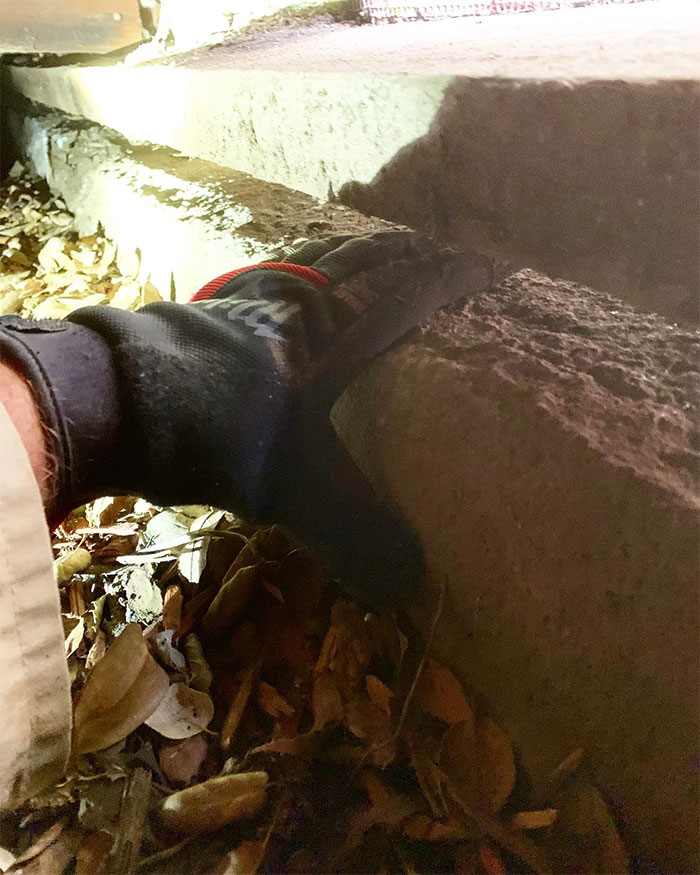
Earthquake safe? I don’t think so.
dangerous-weird-things-structural-inspections
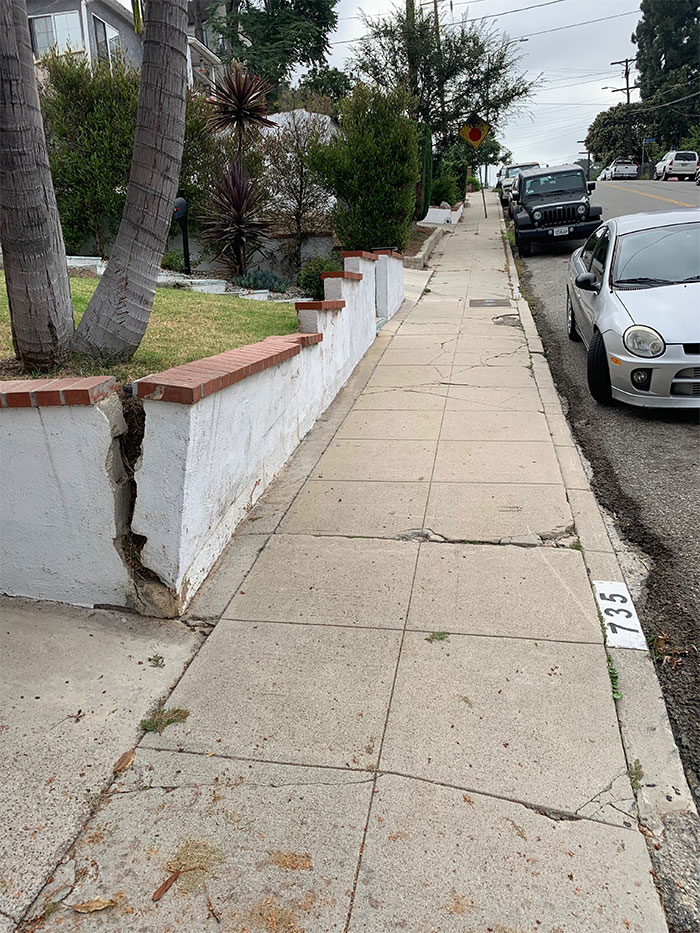
If you go around East Los Angeles, you’ll see this sort of crack in retaining walls on almost every single block. These homes in Silver Lake, East LA, Mount Washington, etc. are all on a moving land mass and when mixed with water and quakes, it makes for a good damage sandwich.
dangerous-weird-things-structural-inspections
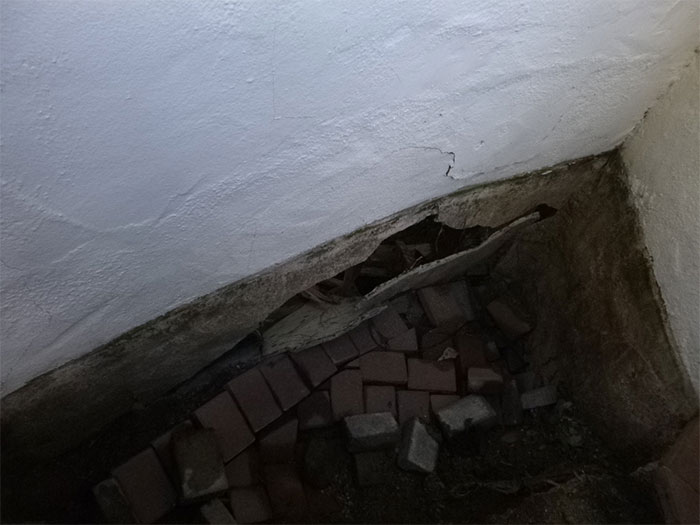
A fake foundation made of plaster that could easily be punctured by an accidental kick.
dangerous-weird-things-structural-inspections
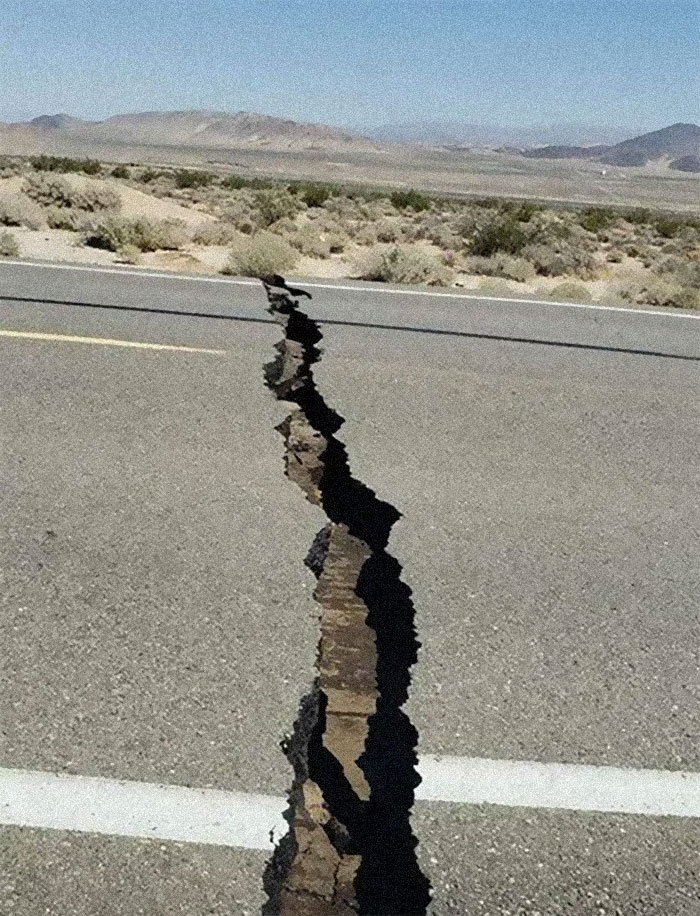
Obviously I didn’t take this photo, but this was a crack in Trona Rd near Ridgecrest, CA where the most recent 6.4 and 7.1 earthquakes occurred in Southern California. There was much more damage than just this crack in the road, but you can imagine if a home was sitting over this area… it would have a hard time staying in place.
dangerous-weird-things-structural-inspections
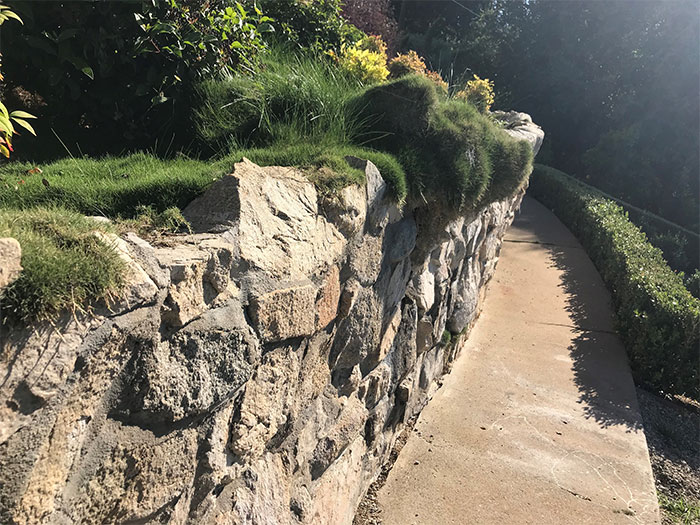
This was a pretty awesome rock and mortar retaining wall, but was unfortunately leaning pretty badly. It will have to be knocked down and redone.
dangerous-weird-things-structural-inspections
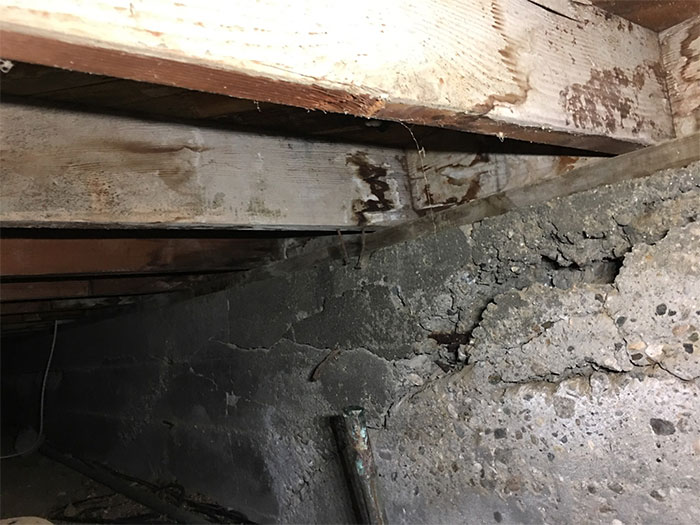
The concrete is in real bad shape and much of it needs to be replaced and then bolted.
dangerous-weird-things-structural-inspections
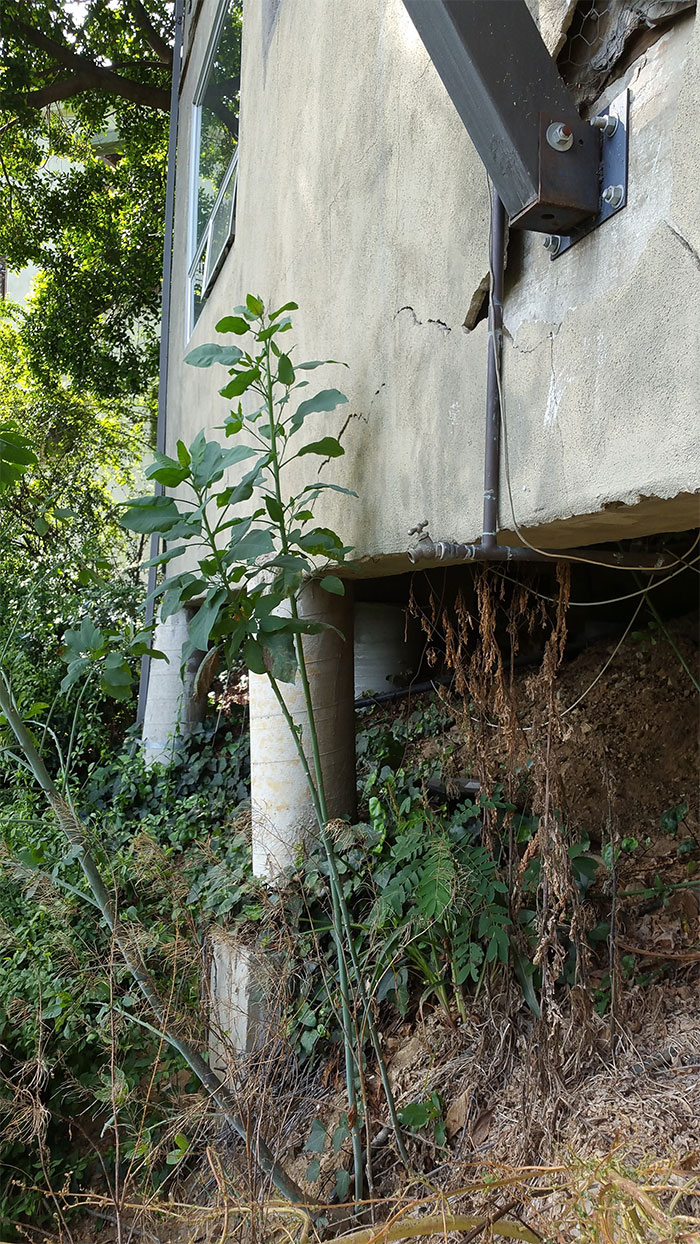
This is a home in the Hollywood Hills that’s sitting on piles. As you can see, the piles are disagreeing with each other and can’t come to an agreement on where to go. Also, notice the cracking above where the piles are. This is a significant structural issue and needs a repairing as soon as possible.
dangerous-weird-things-structural-inspections
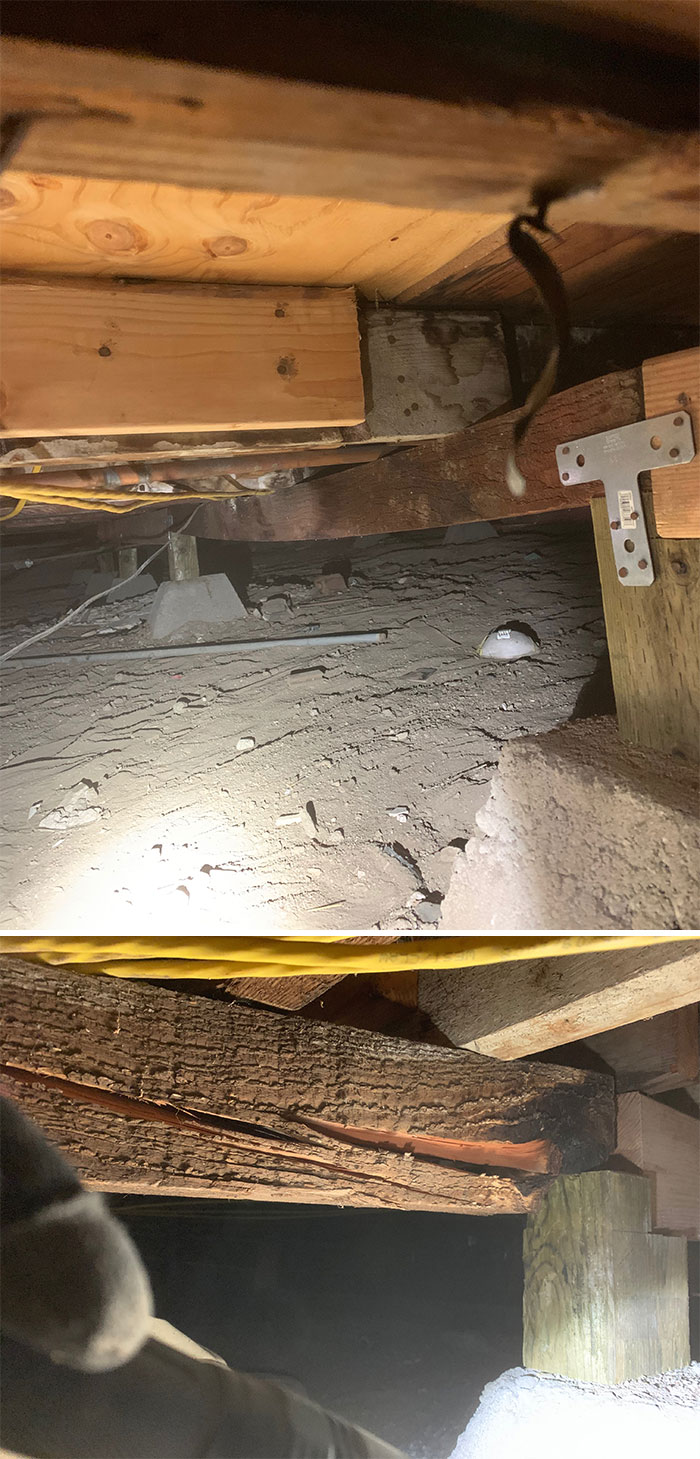
“I have sloping floors.”
The girder was also cracked pretty badly on the other side.
by Jonas Grinevičius via Bored Panda - Source

No comments: